THE LINK to #urbanana:
Rhine cities and the new harbours, part 1 – From breadbasket to neo-port
in English / Reportage: 
»A guiding principle was the creation of a flexible framework that has allowed elements to be developed independently over time by different architects. New infrastructure and public amenities were put in place first to establish the harbour as an attractive place in which to live and work or to visit. A tree-lined promenade was created along the waterfront and canals were excavated as armatures for new housing development.«
Foster + Partners on their master plan for the inner harbour of Duisburg
We explored three harbours that are as different as the cities in which they exist. All three represent a fundamental reorientation and a new revaluation of the Rhine. This large river merges and divides, feeds and caresses, rules and guides life in the three #urbanana cities of Cologne, Düsseldorf and Duisburg. But the river is not the same river it once was. Industries are changing, the currents of globalisation are changing course and harbours are starting to be classified as “subordinate” in importance, as seen in the Rheinauhafen in Cologne, the Düsseldorf-Hafen and the Innenhafen in Duisburg. The successful renovations have demonstrated how decommissioned, unprofitable anchorages are able to transform into state-of-the-art apartment/office/restaurant ports. Despite all their differences, the three new harbours have one common quality: They are large and centrally located.
The biggest hype has surrounded Düsseldorf’s so-called Media Harbour (Medienhafen), which was primarily due to Frank O. Gehry and his Neuer Zollhof development. The wobble-and-waves complex, finished in 1999, made the approximately 10-hectare area suddenly famous. That was also due to the productivity of the Canadian-American architect. At the turn of the millennium, one could not overlook his buildings: the “Dancing House” in Prague (1996, with Vlado Milunić), the Guggenheim Museum in Bilbao (1997), the DZ Bank in Berlin (2001), and the Walt Disney Concert Hall in Los Angeles (2003). The conspicuous and unusual Neuer Zollhof is consistent with Düsseldorf’s overall strategy. Unlike in Cologne or Duisburg, Düsseldorf – the capital of the North Rhine-Westphalia region – has not performed any surface rehabilitation; rather, it has dealt with every plot of land individually, adapting them for future users. Instead of a single urban planning-architectural total concept, several renowned architecture offices have contributed to the overall image of the Media Harbour, among them David Chipperfield, Joe Coenen, Steven Holl and Claude Vasconi.For the Rheinauhafen, the freight forwarding company Häfen- und Güterverkehr Köln AG (Cologne Harbour and Freight) developed the 21-hectare area together with the city of Cologne, and gave the formerly modern industrial harbour a coherent, in parts very clean appearance and framework.
What Gehry was for Düsseldorf, Foster was for Duisburg. The master plan of Foster + Partners, which won the 1991 competition, provided for a combination of work and living, culture and leisure. In the end, multiple building projects were realised on the 90-hectare area, in the context of the international building exhibition IBA Emscher Park: Foster's "Hafenforum", the Küppersmühle Museum and the Land Art artist Dani Karavan’s work of landscape architecture called the Garten der Erinnerung (memorial garden), whose building remnants and concrete walls corresponded with the concrete arms of the Jewish community centre.
As a visitor, one really feels the 100-year history of the harbour and trading centre. This was the very centre of the German grain trade. Until fifty years ago, grain was milled on this site: Thus, Duisburg’s Innenhafen was called the "Breadbasket of the District". Later, it diminished in importance and was threatened by extensive demolition. Today, nothing can be seen of the grain works and the former harbour centre, and the storehouses have become museums, offices and restaurants. The cleaned-up, structured expanse of the new Innenhafen will contrast with the image of a city in crisis, with its 13 per cent unemployment rate and problem neighbourhoods. Instead, the towering mills and storehouses will gleam, confident and clinker brick-red. When one walks around them, the installations and renovations are at first barely recognisable (for example, the Küppersmühle MKM Museum of Duisburg, redesigned by Herzog & de Meuron and completed in 1999). Restraint is the greatest advantage for the renovations of the old houses, and also desired from LEG, THS, Kaiser Bautechnik and Foster + Partners, the winners of the international master plan competition, as the extension with modern, multifunctional architecture. The most important result is that people are really taking to the new residential/office/cultural harbour. They come with their children to the playground near the cultural and city history museums, hold hands with their loved ones as they stroll through the park in the old city, and take advantage of the various gastronomical offerings. A few of the restaurants in the Werhahnmühle, an old mill, score extra points for their historical ambience, which survived the restoration. A look behind the scenes is especially worthwhile. A few of the new buildings, for which the Duisburg native architect Jürgen Bahl is responsible – for example, the Looper office buildings, Hitachi and Five Boats – appear all too clean, forbidding and modular in their glass-and-steel façades. Yet when one circles around them, they surprise the observer, with views toward the interior and the exterior and with their relationship to the water. Thus the H2-Office on Schifferstraße, recreated as a catamaran by Bothe Richter Teherani, appears futuristic and open. Whoever is already here should go in the direction of the A59 highway bridge. From here, one has a view of the entire landscape of the harbour. Here, the new-old brick fortresses and the shining, glassy linear boxes join together to create a harmoniously smooth overall picture.Compared to the views from the Rheinauhafen and the Media Harbour in the nearby inner cities of Cologne and Düsseldorf, the Innenhafen makes a rather hermetic impression. All the more surprising is the moment when one comes from the nearby inner city and sees the airy clarity of the Innenhafen, whose development is not yet finished. Further building projects – like the spectacular The Curve – are planned, as is a stronger connection to the city centre. Not a bad outlook for a city that has been hit hard by structural change, and one that has proven with the Innenhafen that it can re-orient itself successfully.
Innenhafen Duisburg (inner harbour)
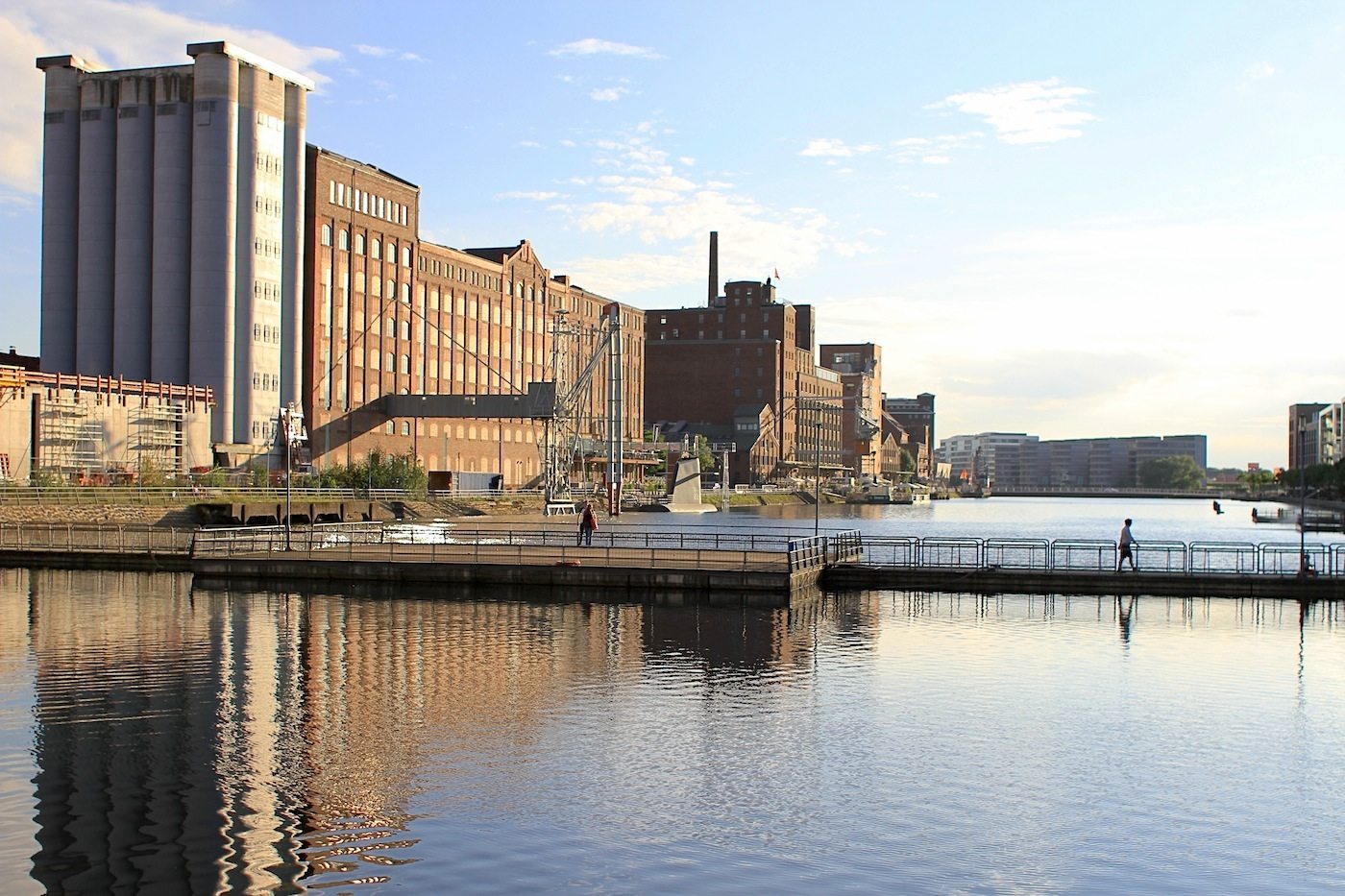
Innenhafen Duisburg
For more than 100 years, Innenhafen Duisburg used to be a place of commerce and transhipment. At an area of almost 90 hectars, its downtown location and the listed mills and warehouses that shape the townscape provided a unique development potential, which is being utilised to convert the old port into an urbanistically and architecturally sophisticated new and attractive quarter.
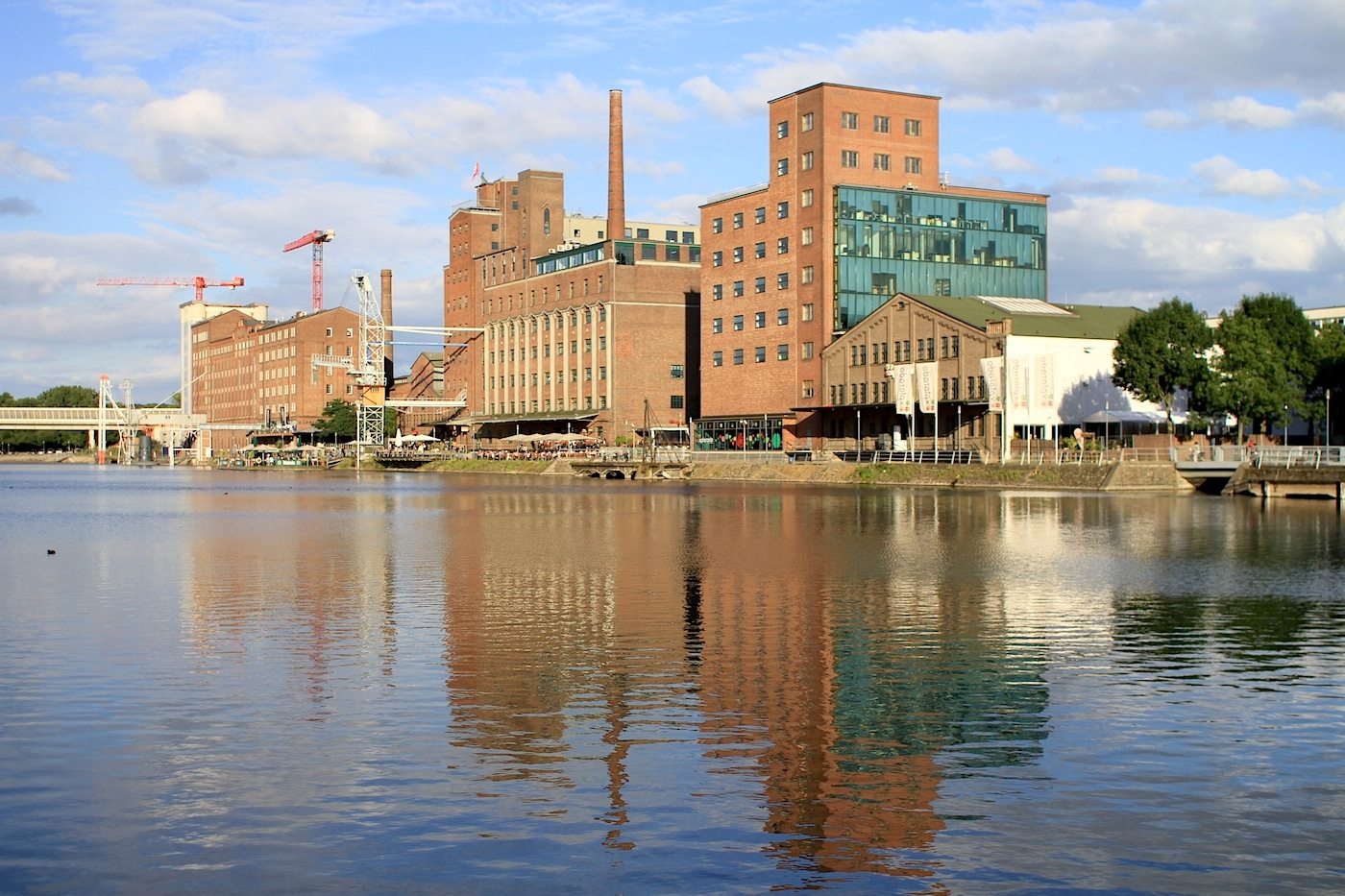
Innenhafen Duisburg
Situated right next to the historical city wall and only a few minutes from downtown Duisburg, around the architecturally attractive warehouses and mills a multifunctional service centre is developing. Based upon a master plan drawn up by British architect Lord Norman Foster, within the framework of the Internationale Bauaustellung Emscherpark (construction exhibition) an integrated intra-urban development concept has been realised in an exemplary fashion. The sensitive conversion of listed mills and warehouses (e.g. Küppersmühle, Hafenforum, Faktorei 21) was as much part of the revitalisation projects as spectacular new buildings (e.g. Five Boats, H²-Office, Eurogate, Hitachi Power Office). Within the framework of the mixed use of the area , that is, working, living, leisure and culture, all construction projects were somehow associated with “water” in terms of both their function and design. It was thus possible to bring the port into town and the town to the port, as it were.
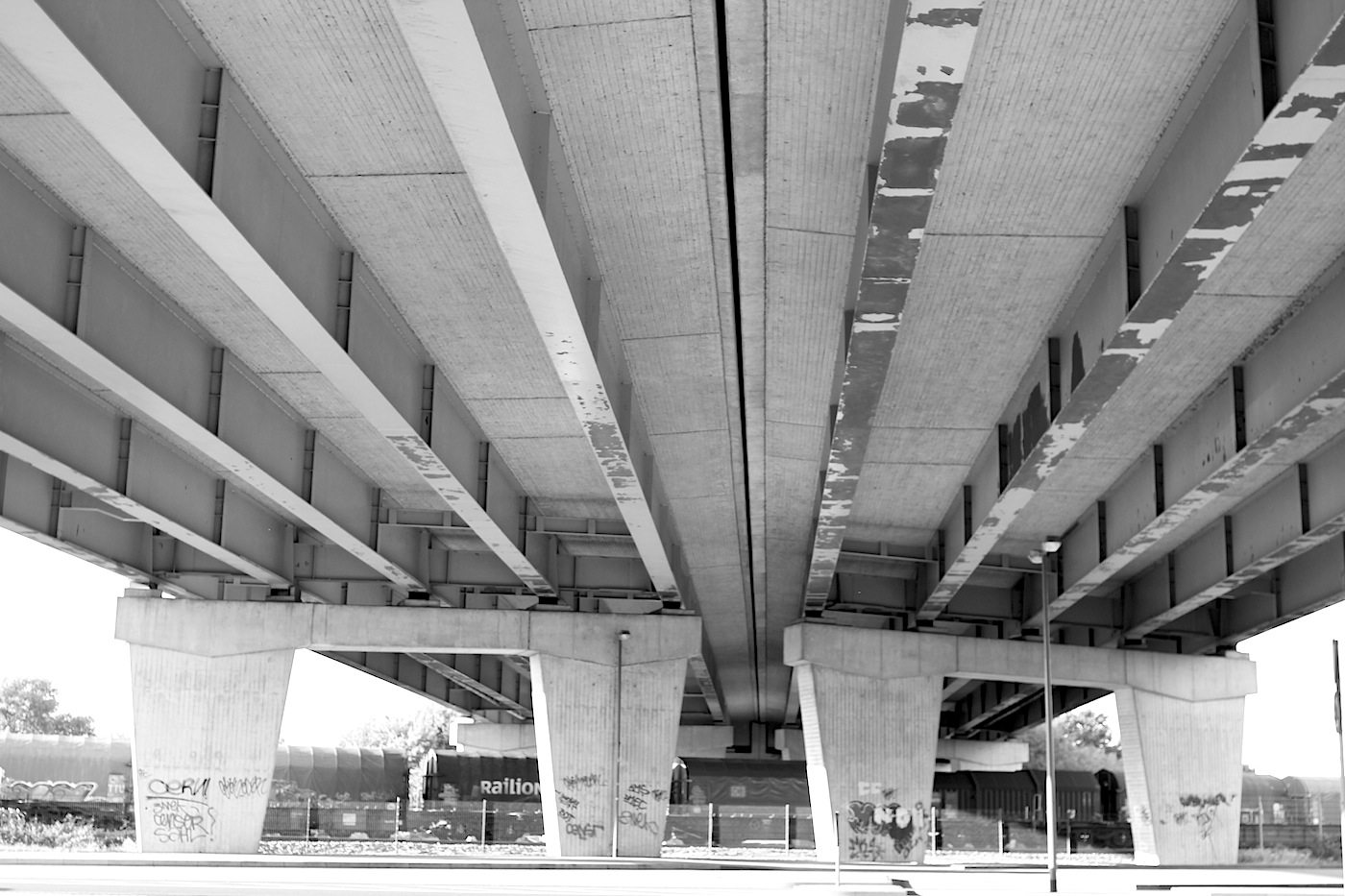
A59
Whoever is already here should go in the direction of the A59 highway bridge. From here, one has a view of the entire landscape of the harbour. Here, the new-old brick fortresses and the shining, glassy linear boxes join together to create a harmoniously smooth overall picture.
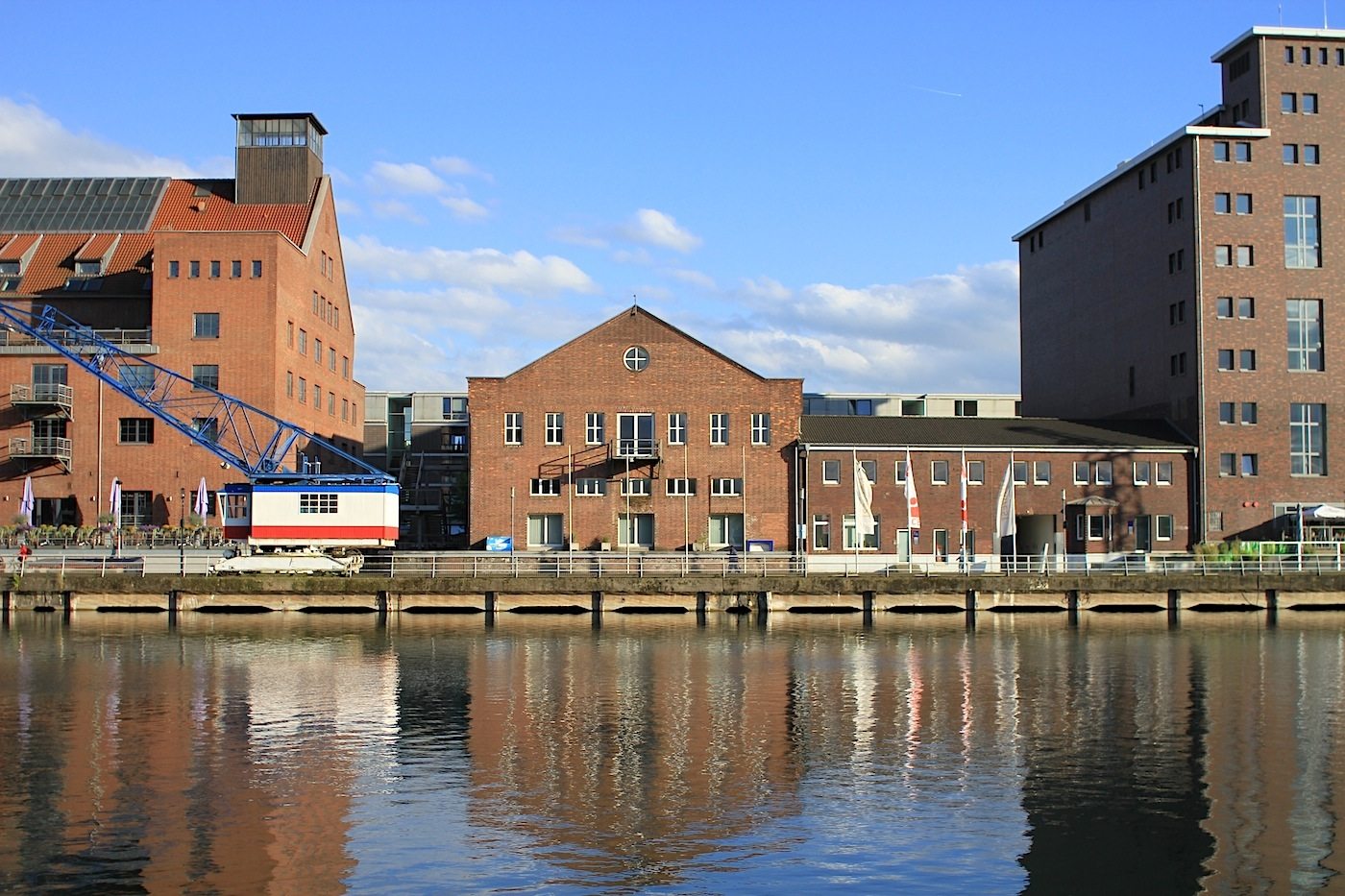
Hafenforum
By Norman Foster, completed in 1996. A former warehouse, now an office building and information center.
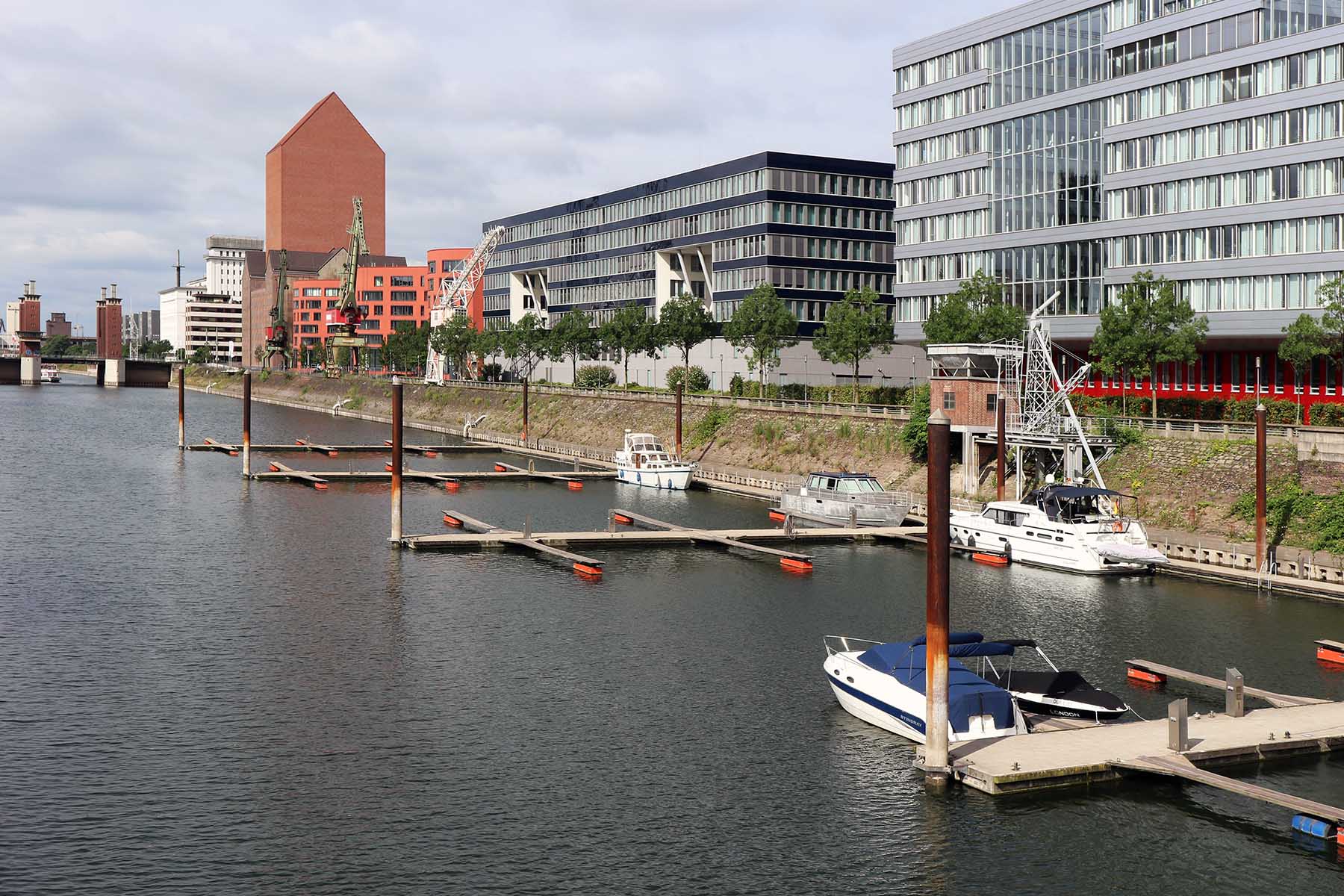
Innenhafen Duisburg
The Marina with the Landesarchiv NRW, the state archive of North Rhine Westphalia, by Ortner & Ortner Baukunst.
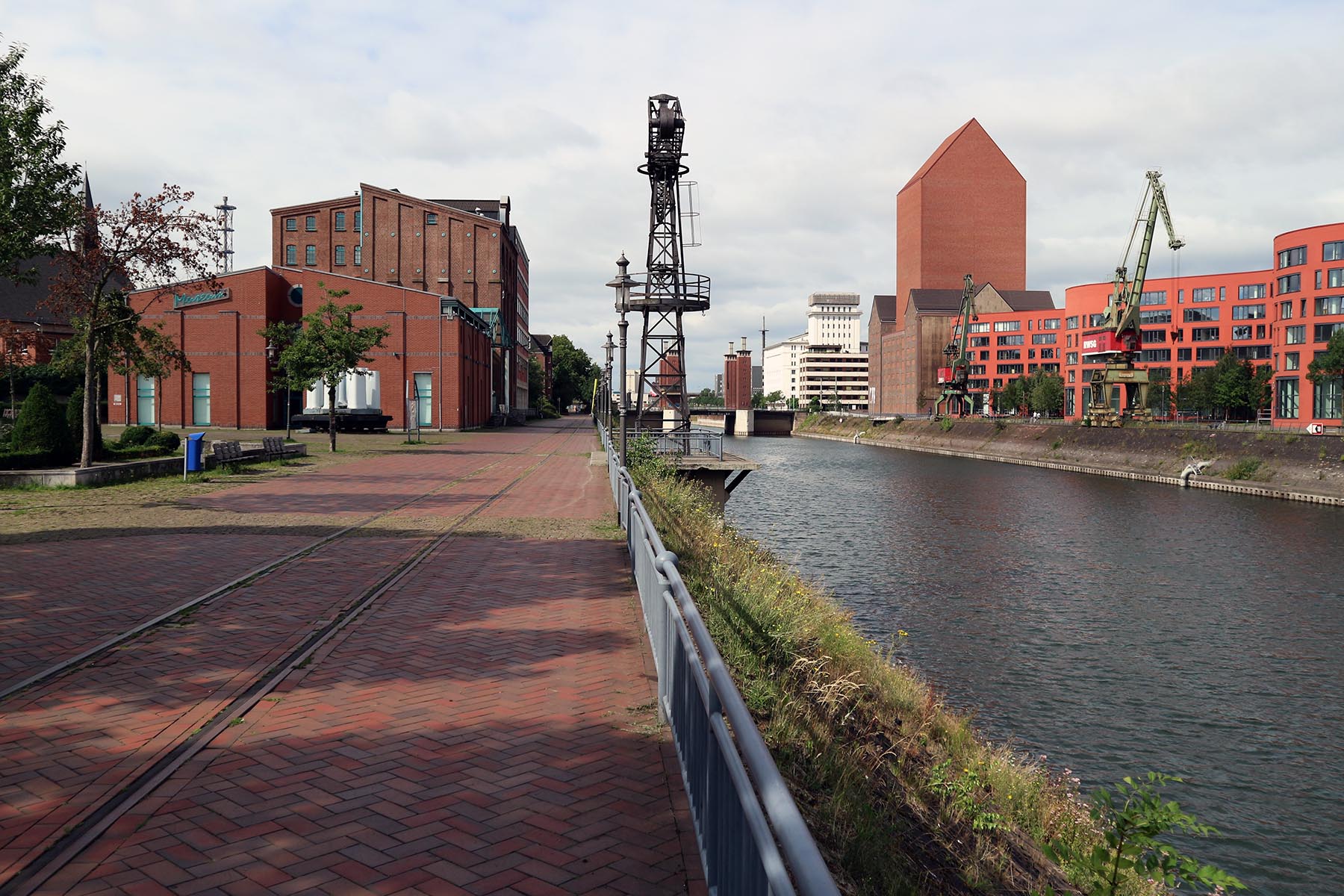
Innenhafen Duisburg
The Kultur- und Stadthistorische Museum (historical and cultural museum) and the building of the state archive of North Rhine Westphalia.
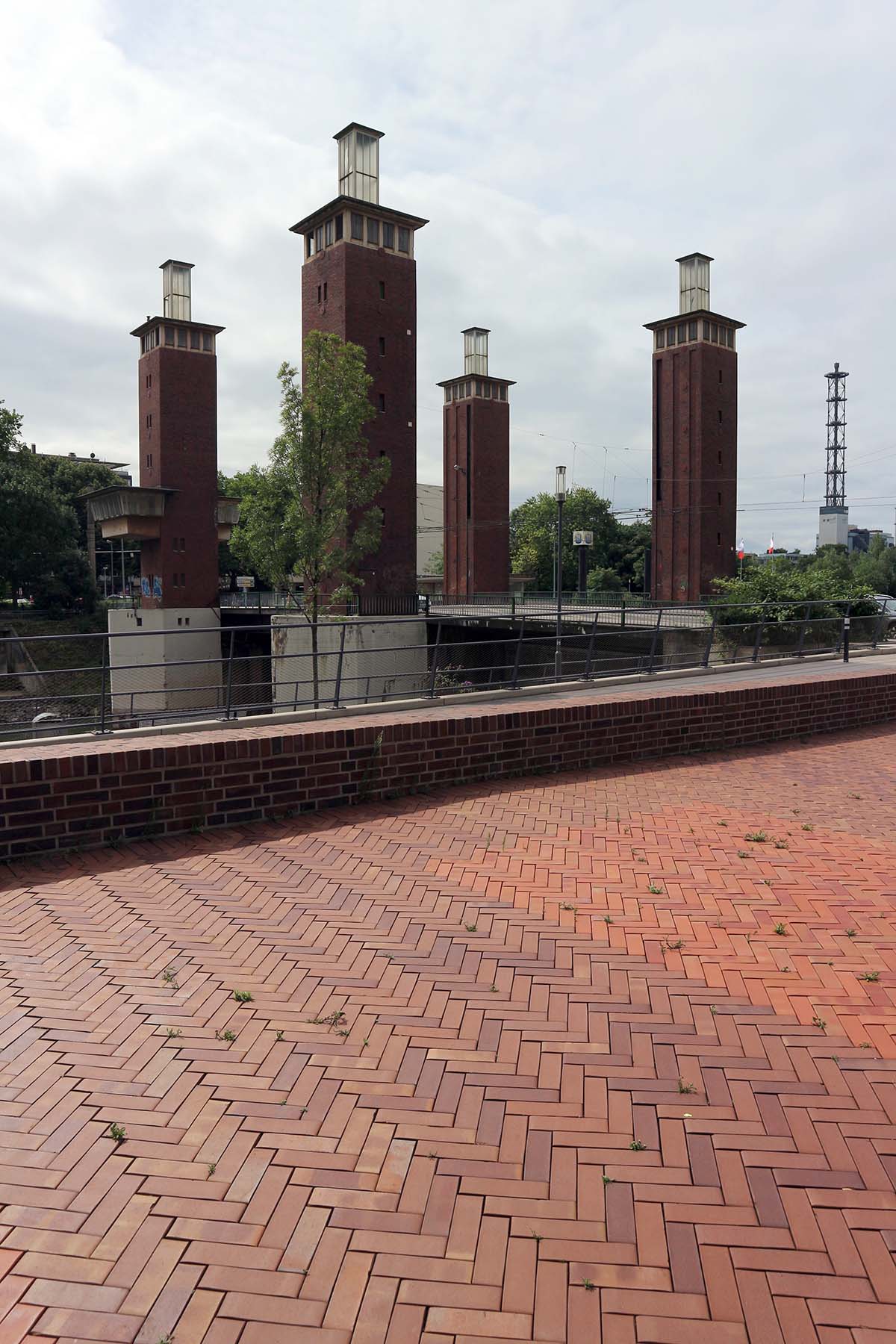
Schwanentorbrücke
By Hans-Siegfried Persch, 1950, one of three lift bridges in Duisburg.
Landesarchiv NRW (State Archives of North Rhine Westphalia) by Ortner und Ortner Baukunst
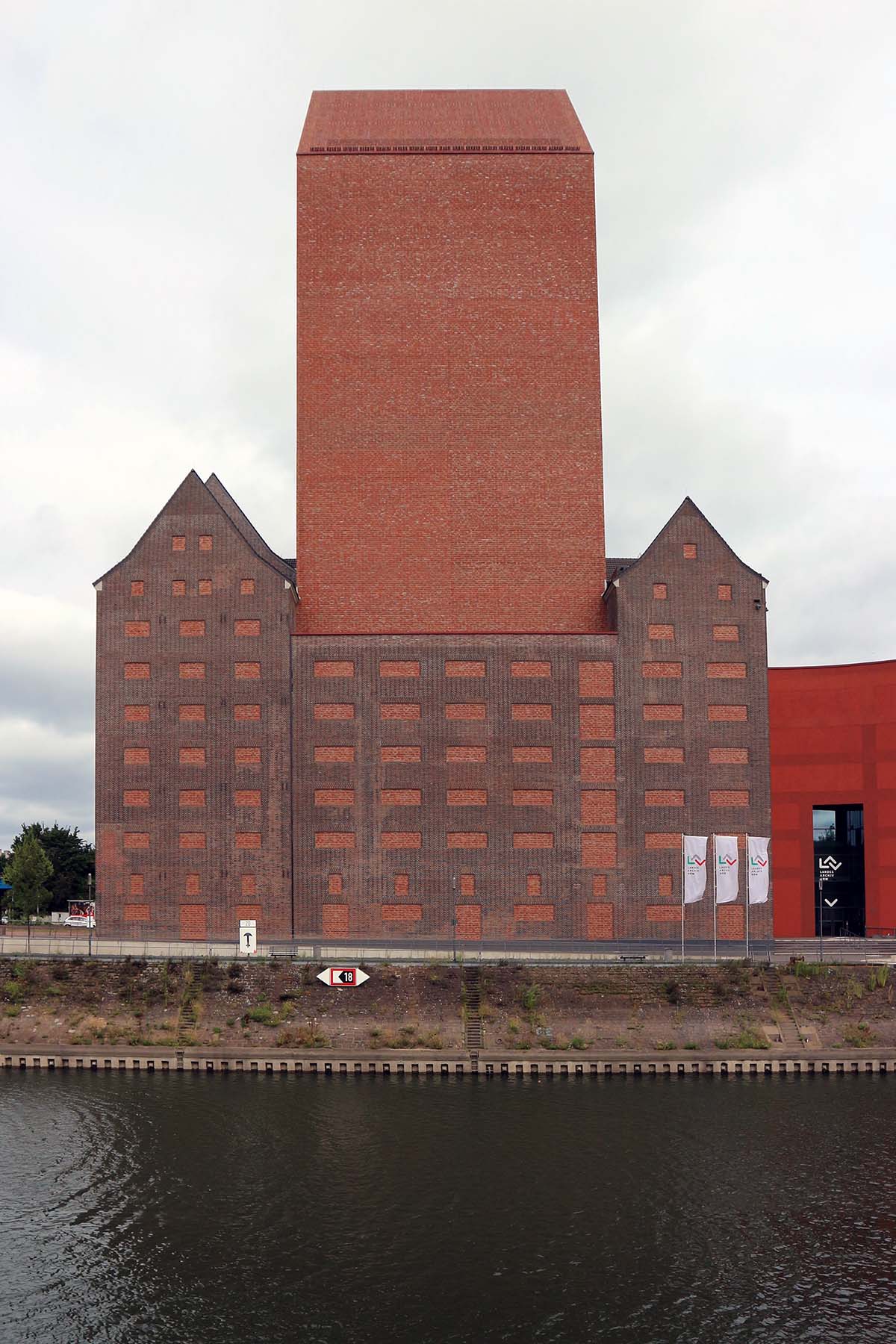
Landesarchiv NRW, the state archives
By Ortner und Ortner Baukunst, Düsseldorf and with offices in Berlin, Cologne and Vienna.

Landesarchiv NRW
Towards the motorway and the inland port, the NRW State Archive presents itself as a prominent brick building.
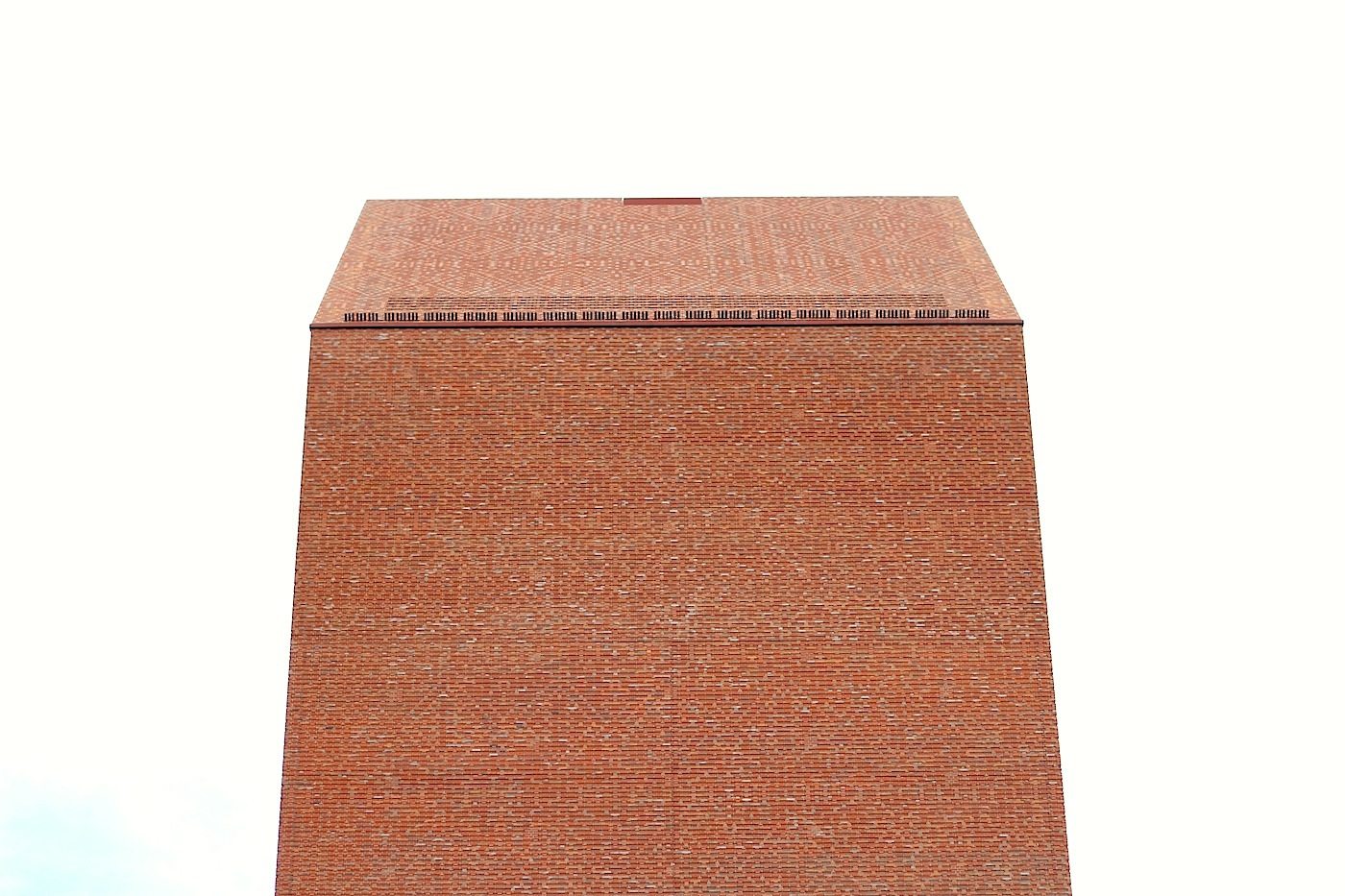
Landesarchiv NRW
An archive tower at the centre is added to the existing warehouse from the 1930s.
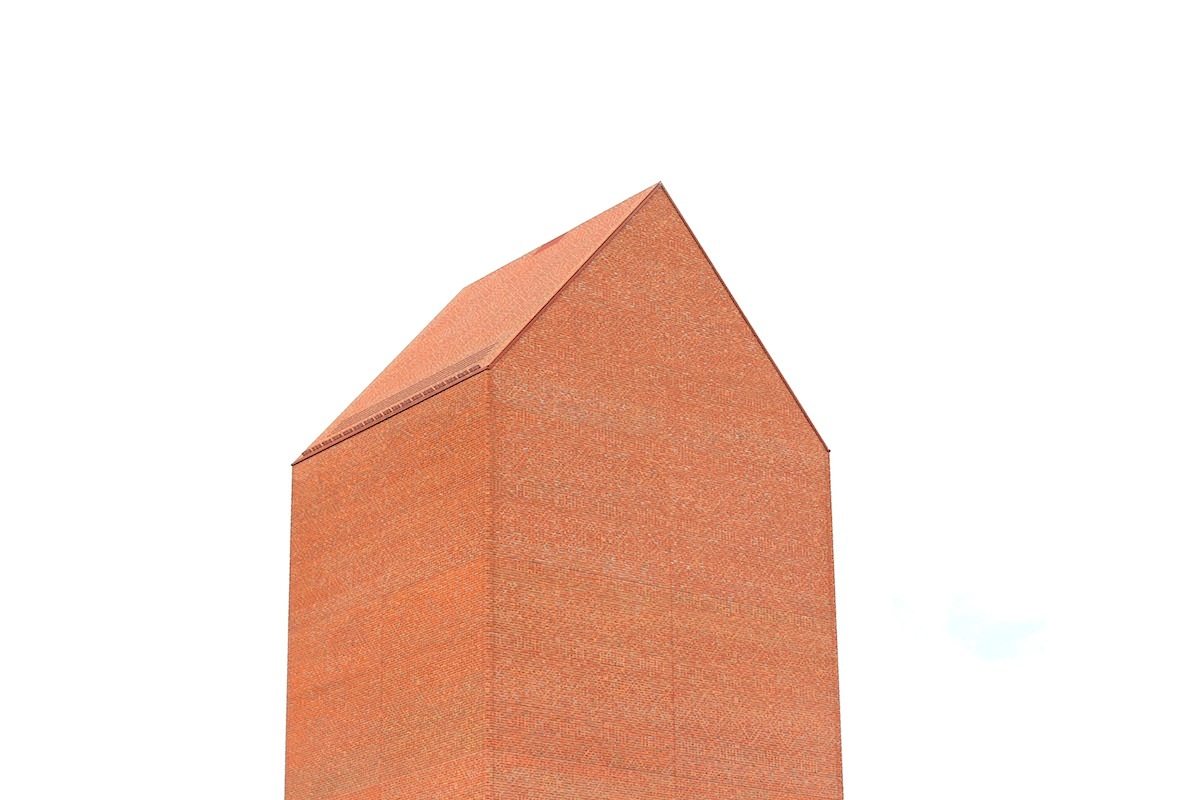
Landesarchiv NRW
The archive material, previously distributed in a number of different locations, can now be brought together and can be made visible in built terms as society’s memory.
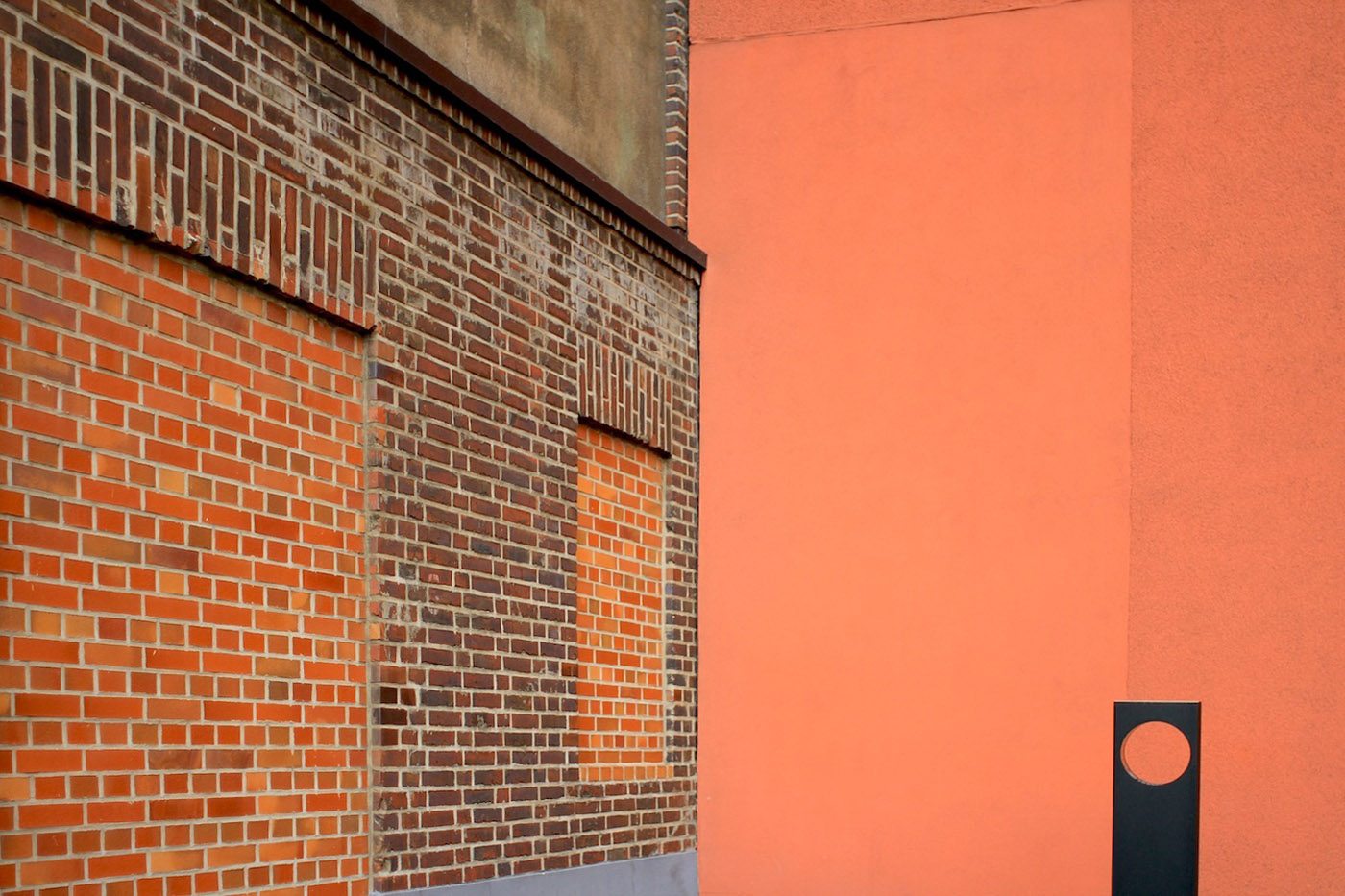
Landesarchiv NRW
The façade openings and the skylights of the existing warehouse are closed up and the clinker brick façade is cleaned.
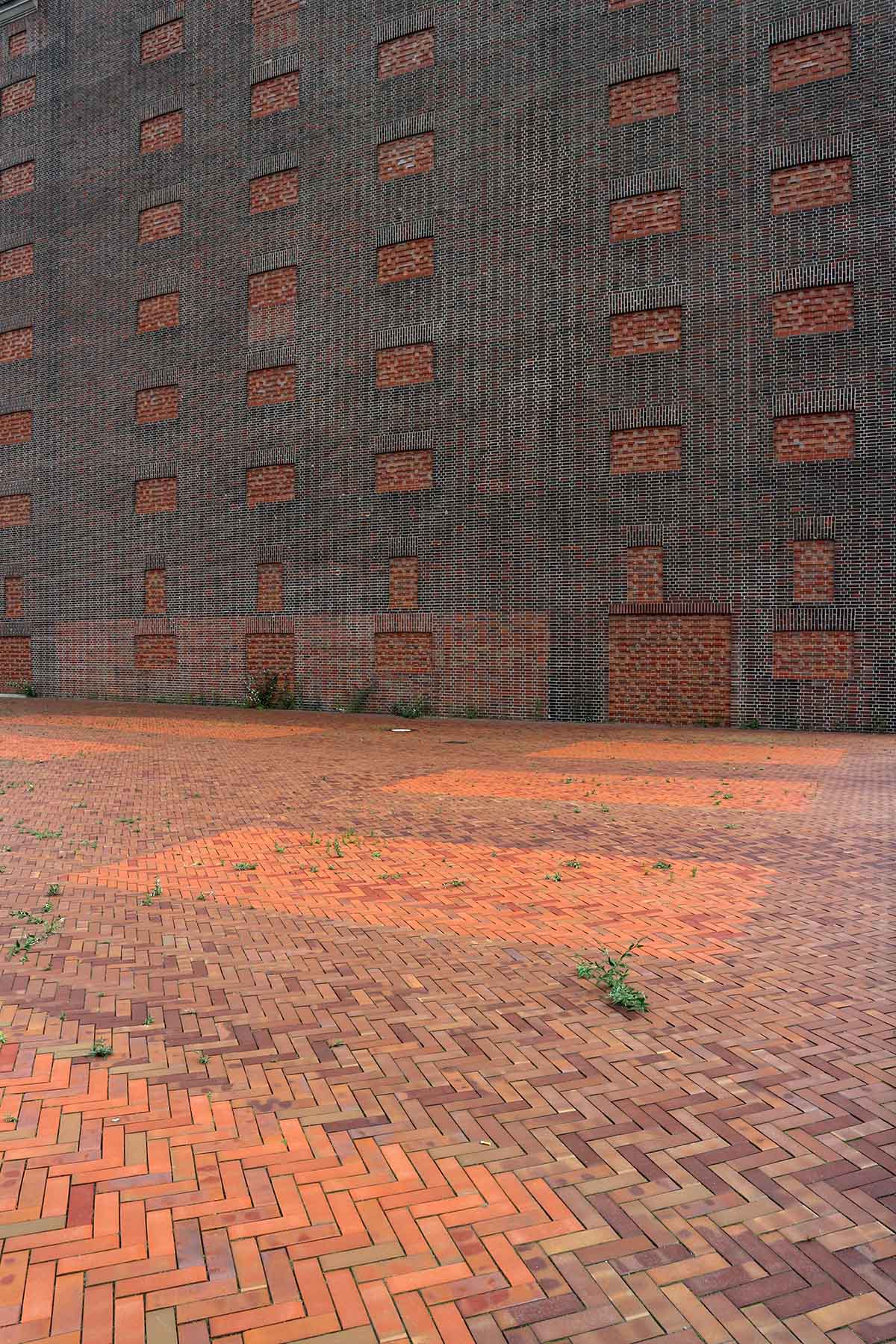
Landesarchiv NRW
The new storage tower is distinguished from the old brick structure by the use of a fine relief.
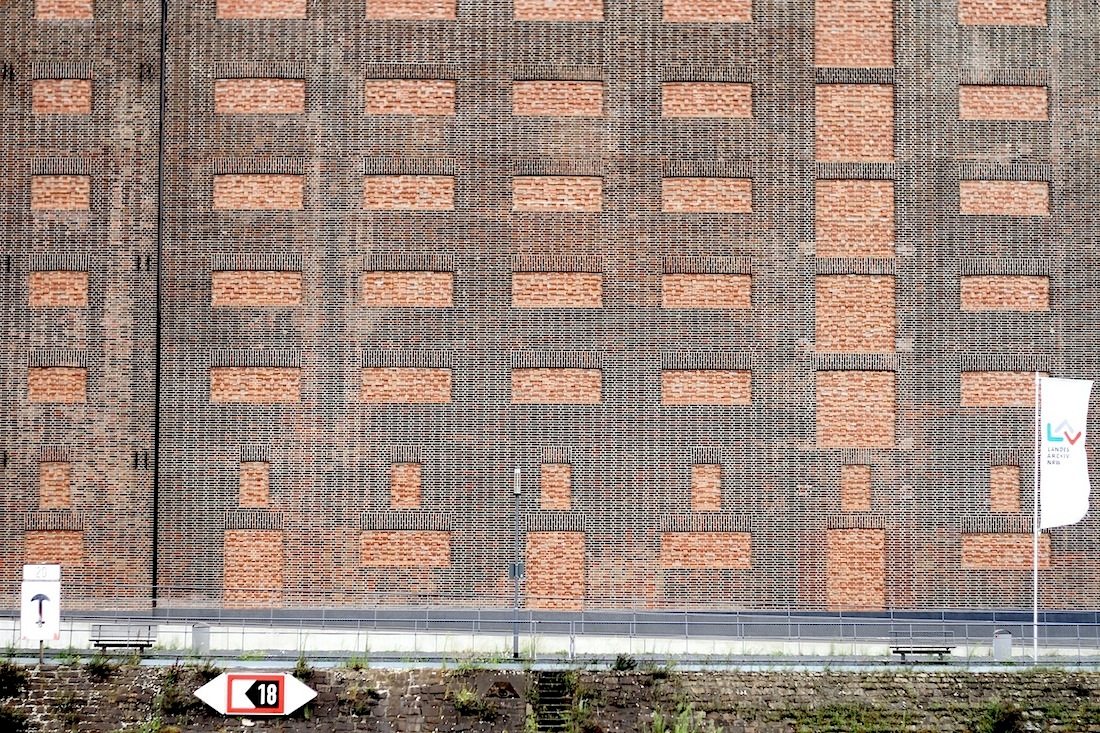
Landesarchiv NRW
The edges and surfaces are softer, less easily grasped by the eye.
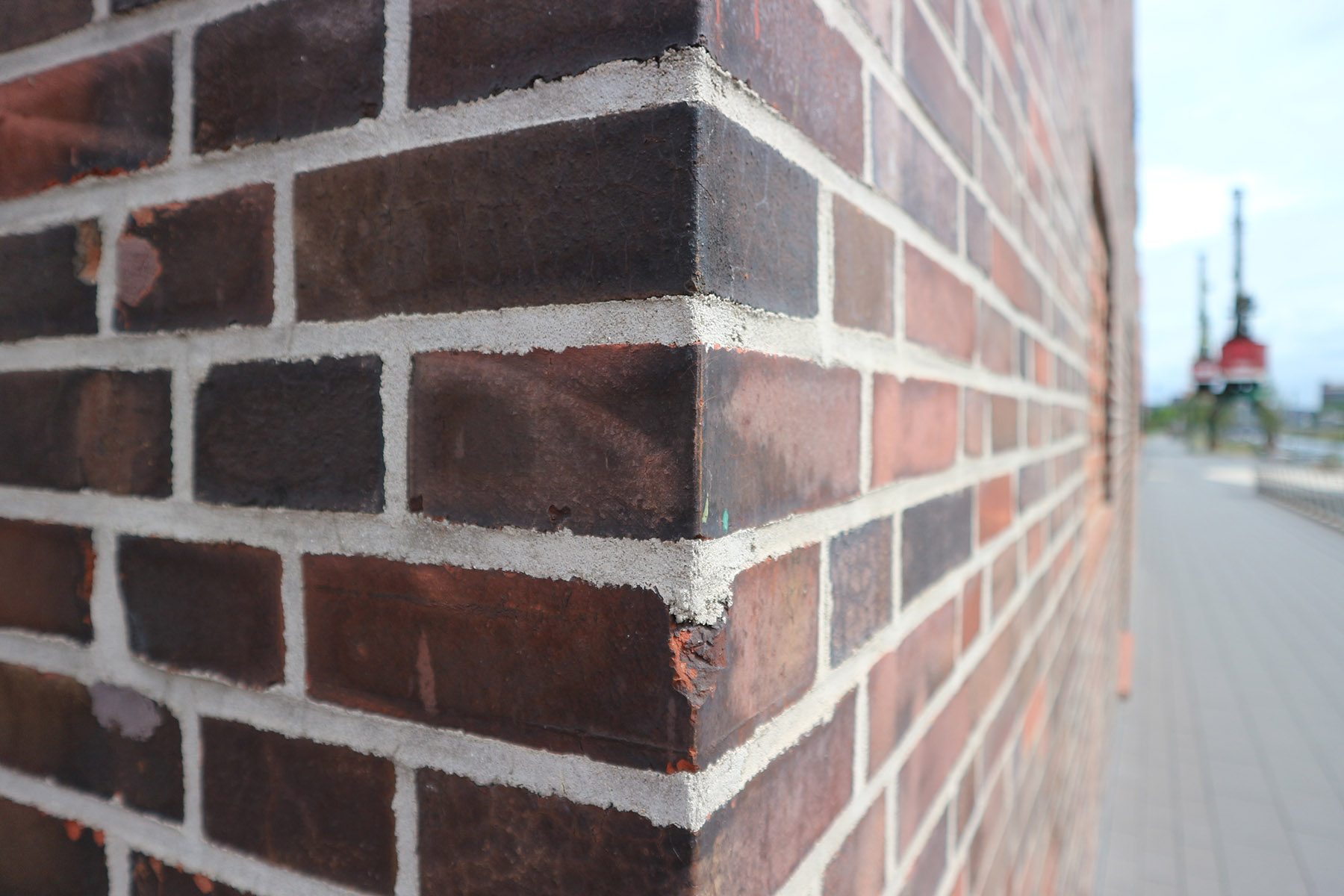
Landesarchiv NRW
The five-storey addition that meanders along the inland port houses the foyer and administration ...
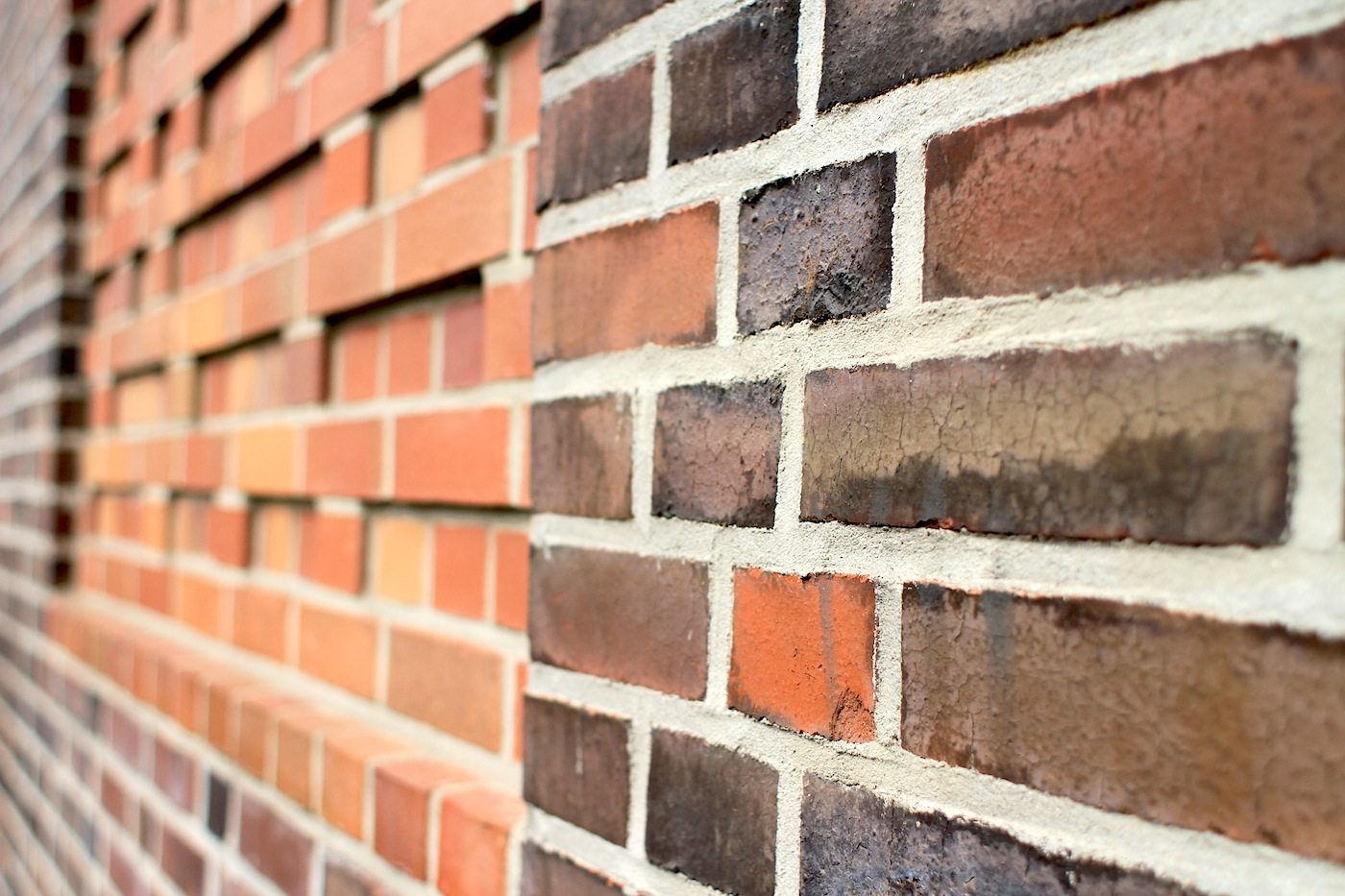
Landesarchiv NRW
... as well as a number of other functions.
MKM Museum Küppersmühle
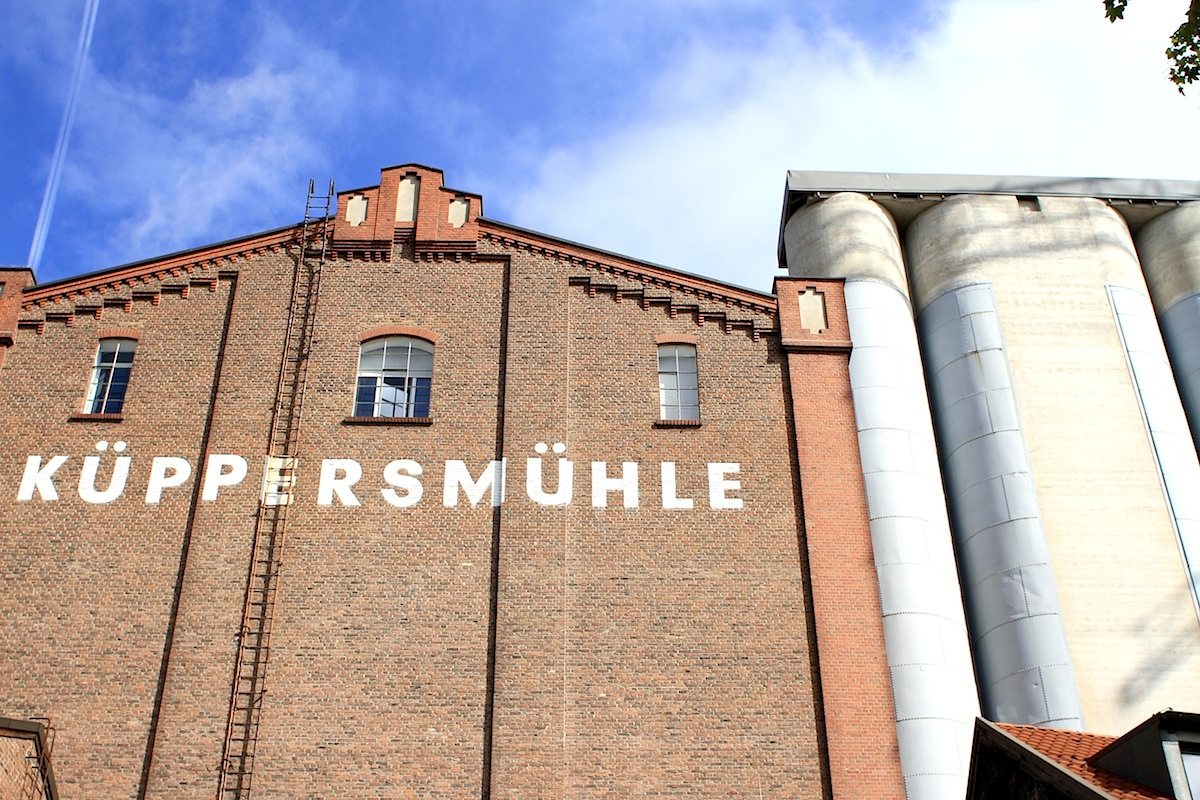
MKM Küppersmühle
Küppersmühle by Kiefer brothers and Joseph Weiß, completed 1916. The founding of the millworks in 1860 on the site of today’s Küppersmühle Museum traces back to the entrepreneur Wilhelm Vedder, who was important to establishing Duisburg’s Inner Harbour as the „breadbasket of the Ruhr region“. In 1908 this original structure was then replace by the current three-wing building, now converted into the museum. In 1969 the company merged with the Homberger Küpperswerke, from which the name of the museum now derive. The mill was closed down in 1972.
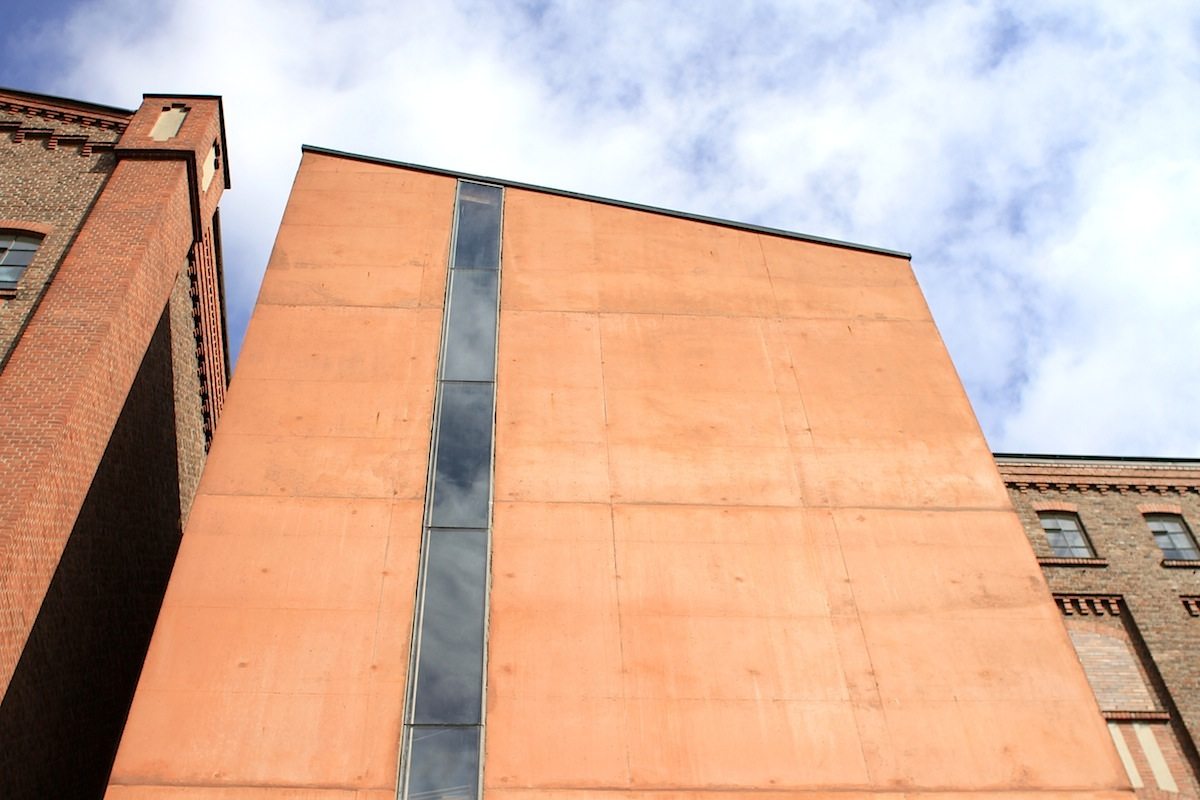
MKM Küppersmühle
From industrial building to museum: Based on the masterplan devised by the British architect Sir Norman Foster, the redevelopment of this derelict inland harbour into a multifunctional quayside service park was executed as part of the International Building Exhibition Emscher Park (IBA 1989-1999). Successfully applied in many other urban centres, this concept of creating a residential, commercial and leisure area on the waterfront was implemented in immediate proximity to the City itself. The disused mills and warehouses of the former grain port, retained as a distinctive city landmark, have now been converted into a mixed-use complex, incorporating, for example, the Museum for Modern Art (MKM), housed in the former Küppersmühle grain mill.
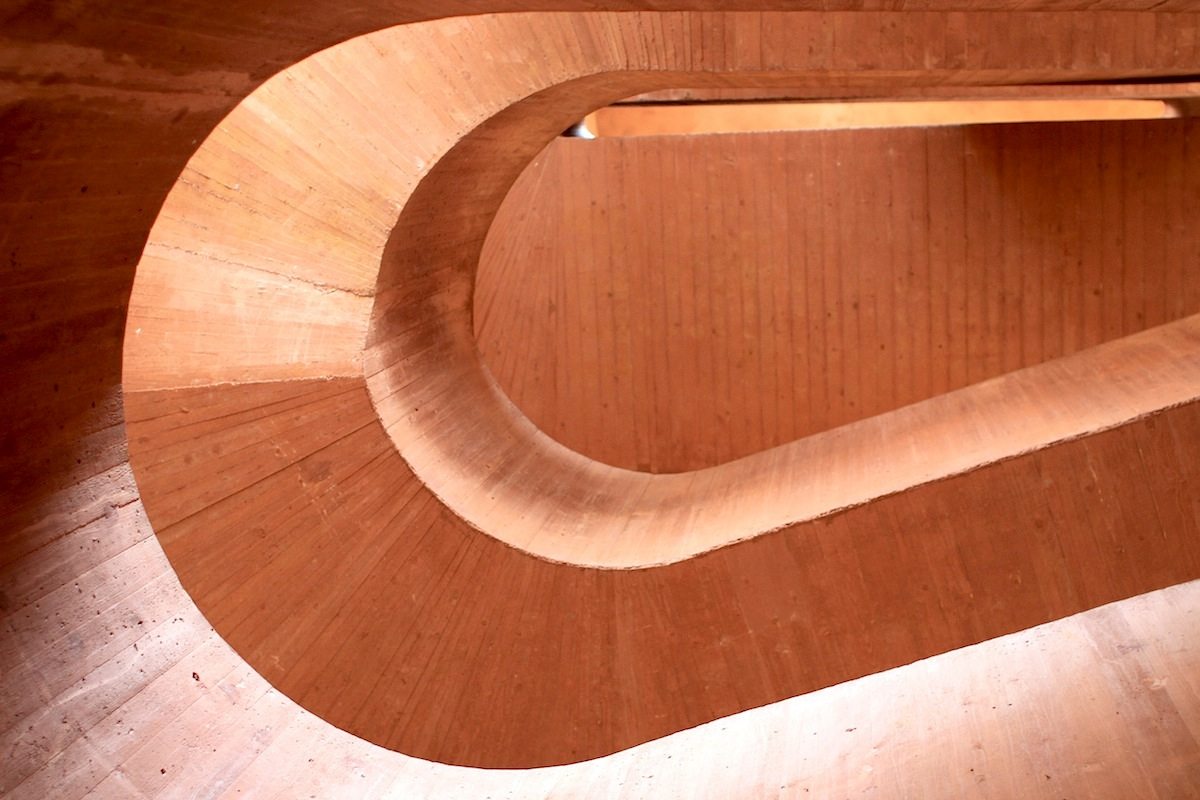
MKM Küppersmühle
Commissioned to undertake the redevelopment were the architects Herzog & de Meuron. They succeeded, on the one hand, in preserving the industrial character of the historic edifice whilst, on the other, creating functional premises for displaying contemporary art. The brick facades of the old Küppersmühle were retained, and an exhibition space of some 3,600 sq.m. was created.
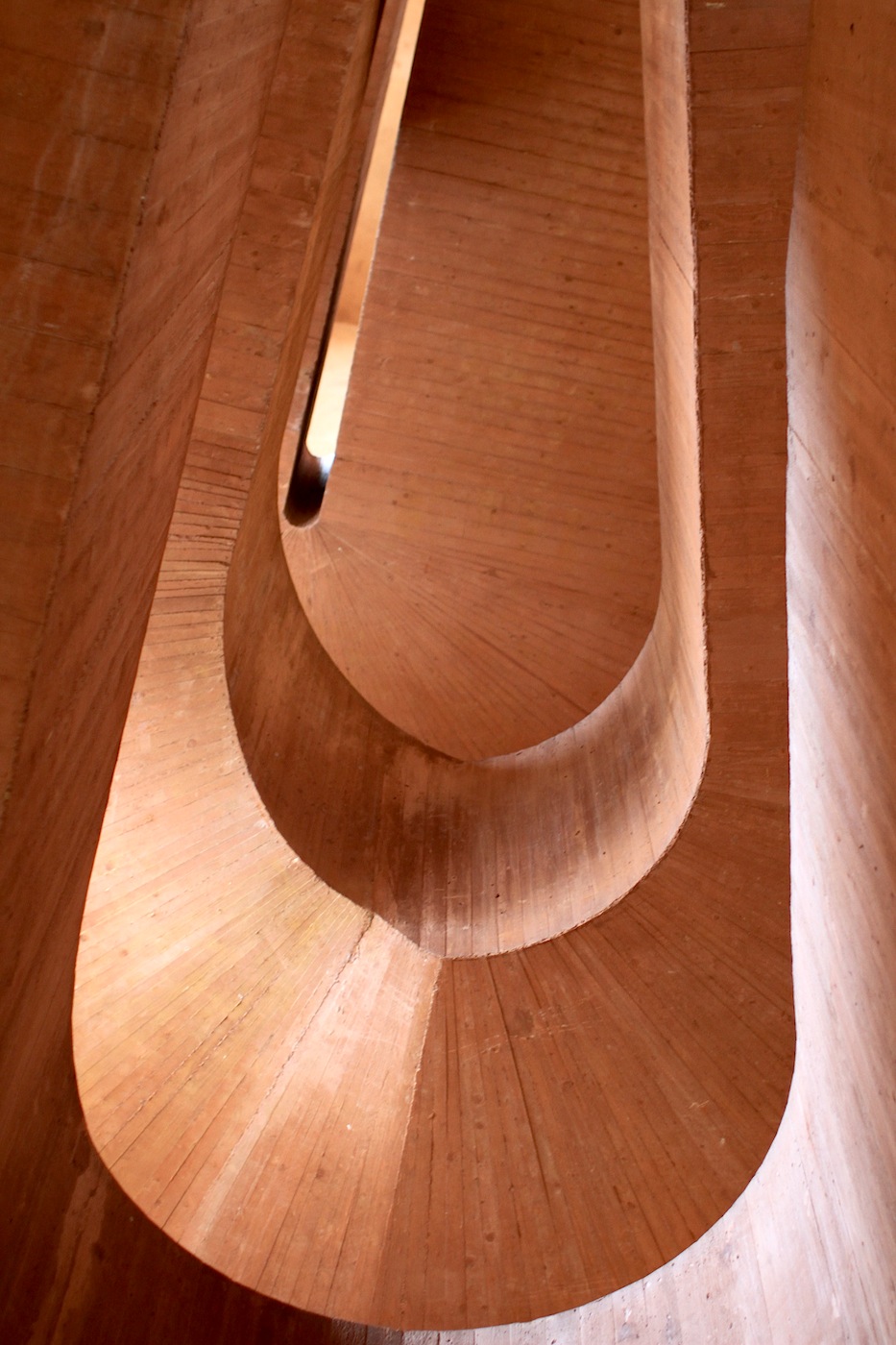
MKM Küppersmühle
The only new addition is the staircase, attached to the front of the building, which each year attracts many visitors keen to view its impressive architectural features.
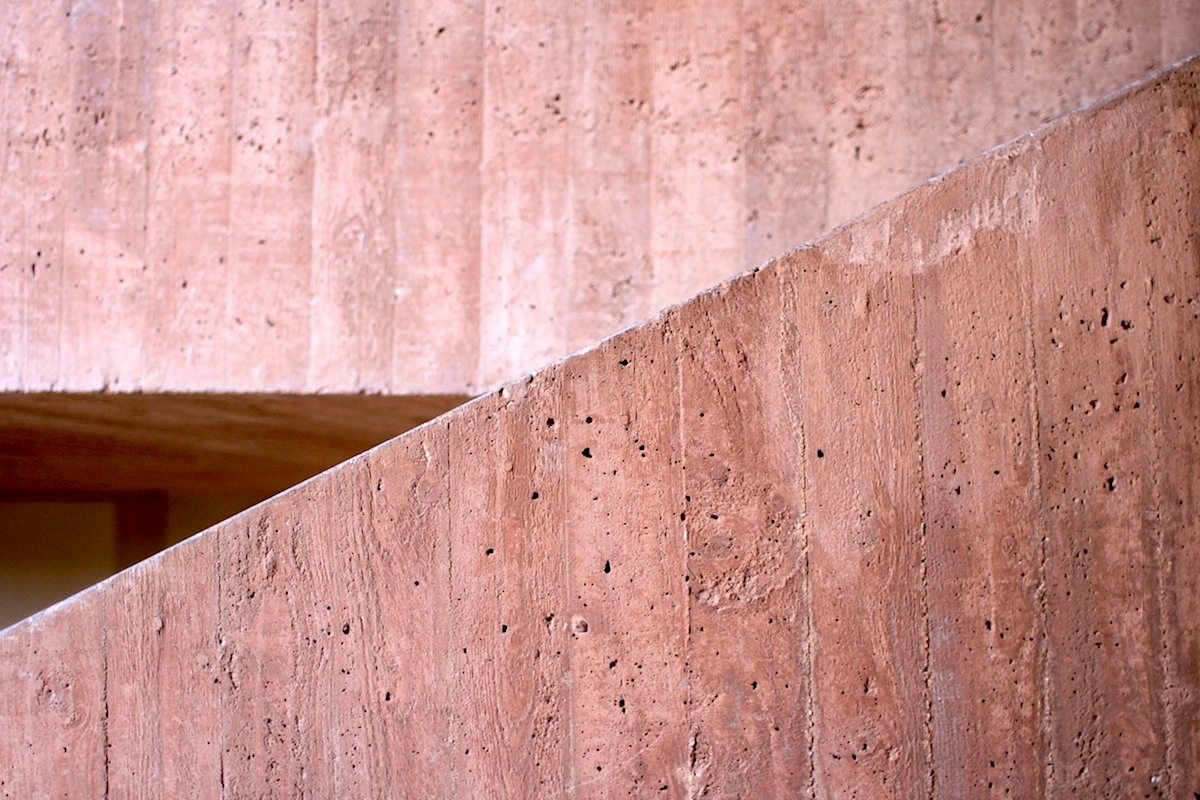
MKM Küppersmühle
The winding stairtower – built from terracotta-coloured concrete and still bearing the visible traces of the formwork – draws our eyes inexorably upwards. Similarly, the broad terrazzo stairs furnish an invitation to ascend to the upper storeys. Designed especially for this section of the building, the light fittings take on the appearance of iridescent wax tapers. The meticulously hand-painted murals form an ideal counterpoint to the warm, terracotta tones and highlight the staircase as an autonomous architectural work of art.
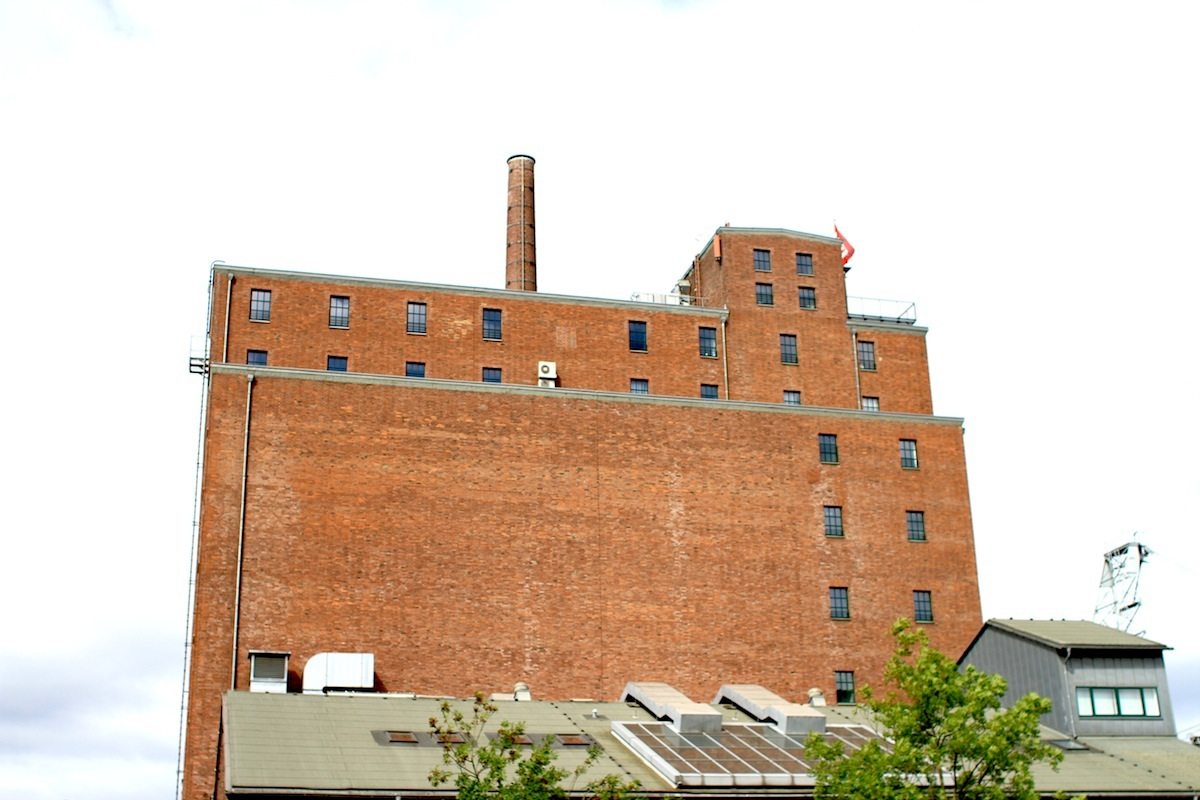
Werhahn Mühle
A complex of offices, restaurants and a museum located in Duisburg’s Inner Harbour.
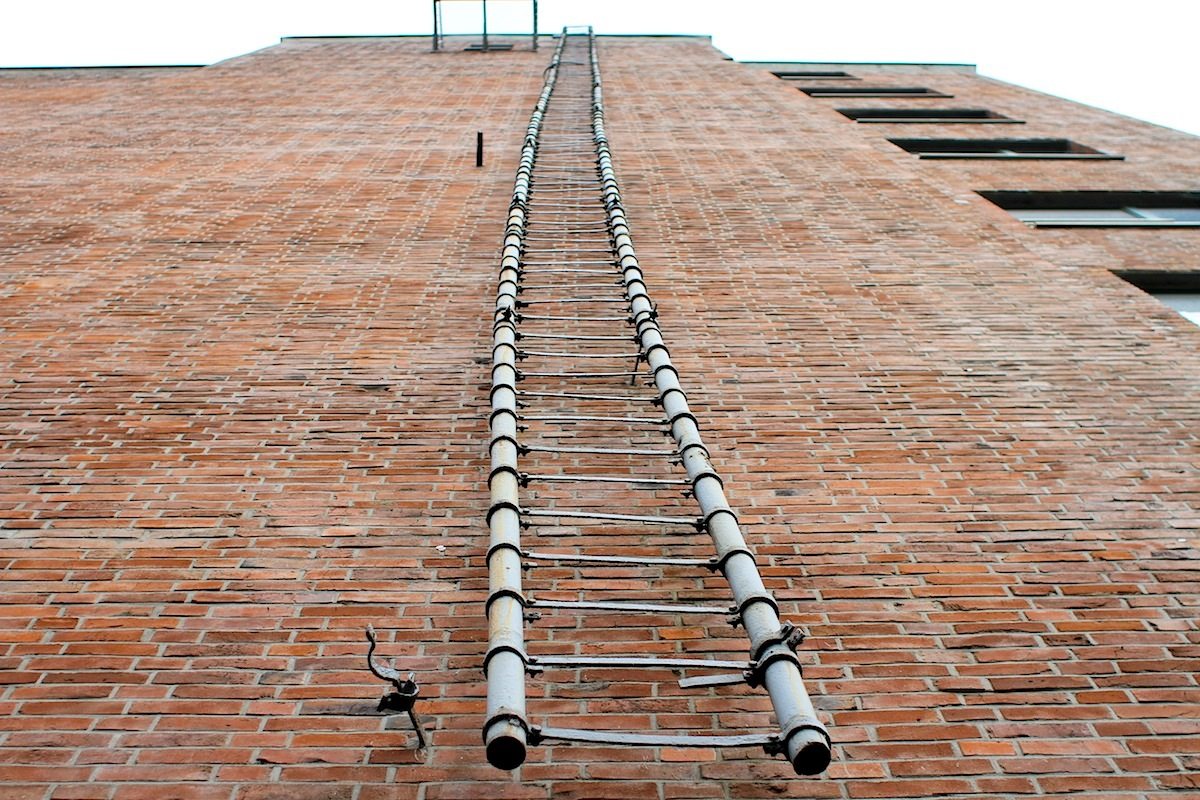
Werhan Mühle
It occupies the former silo and mill buildings of the Rheinische Mühlenwerke Werhahn.
Garten der Erinnerung (memorial garden), Jewish community centre and new constructions
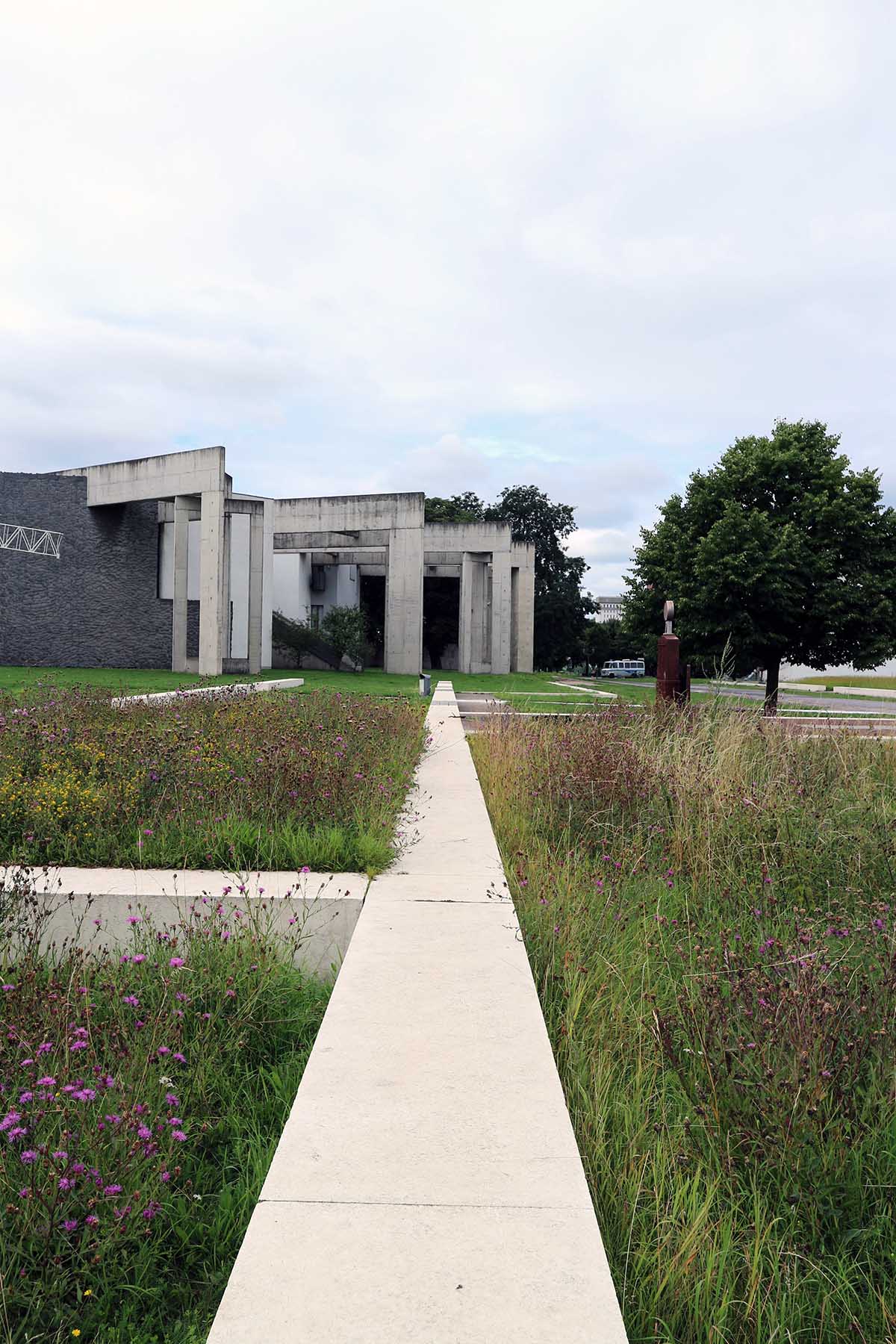
Garten der Erinnerung (memorial garden), Jewish community centre
By Dani Karavan, completed in 1998. In the memorial garden, visitors are reminded of how this part of the inner port used to be used. Structural remains of the post-war architecture are used as observation towers or as stages for events.
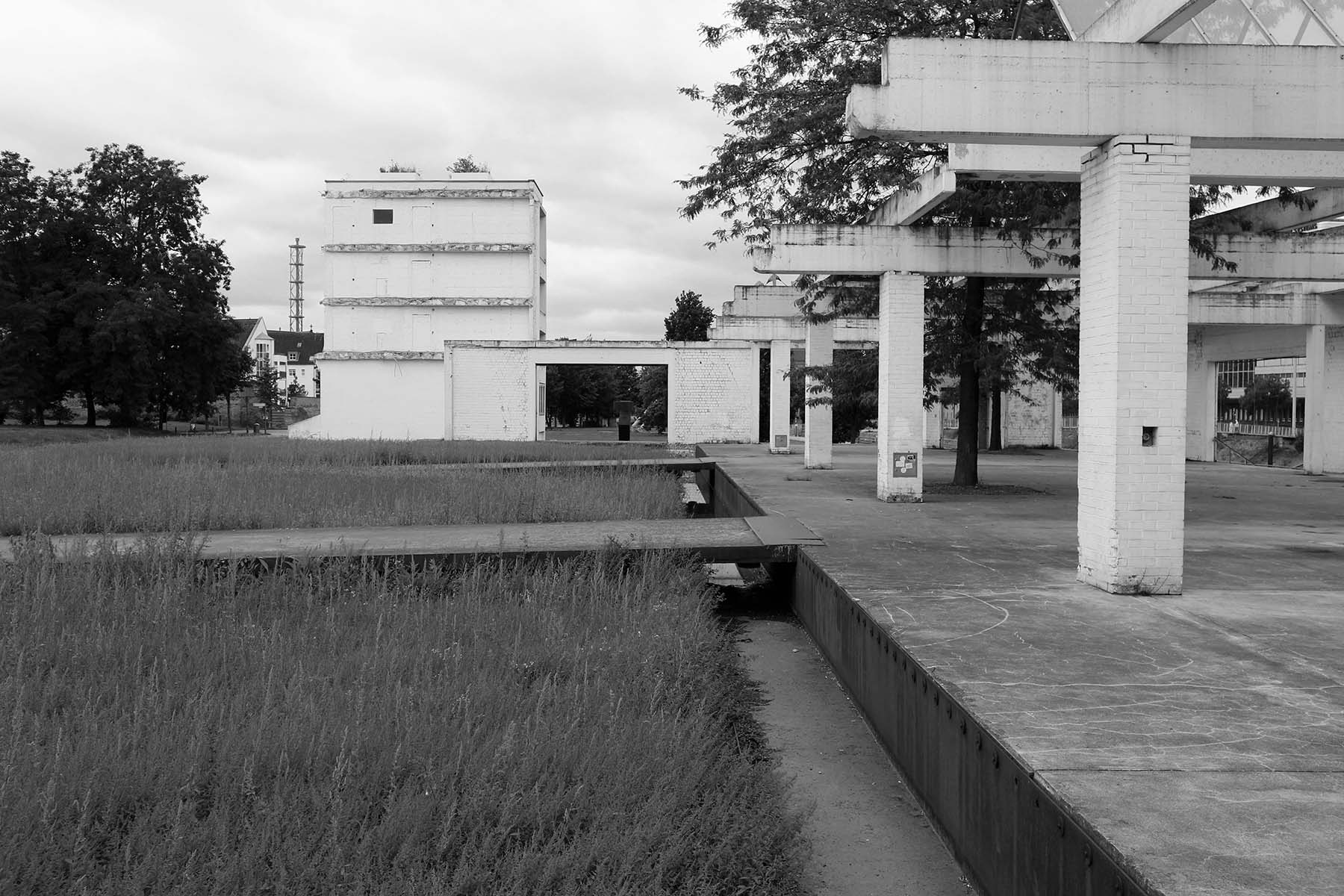
Garten der Erinnerung (memorial garden)
The conversion of these remains into parts of the park is symbolised by the planting of mountain pines on the towers and the honey locusts in the floor covering between the Ludwigsforum construction grid in particular. White concrete walls trace the old ground plans of the buildings and sheds and frame the various areas. Their former use is outlined by various "vegetation maps". The corn transhipment function, for example, - "the Ruhr area's bread basket" – is symbolised by a three-field-crop-sunflower rotation in front of the Ludwigforum.
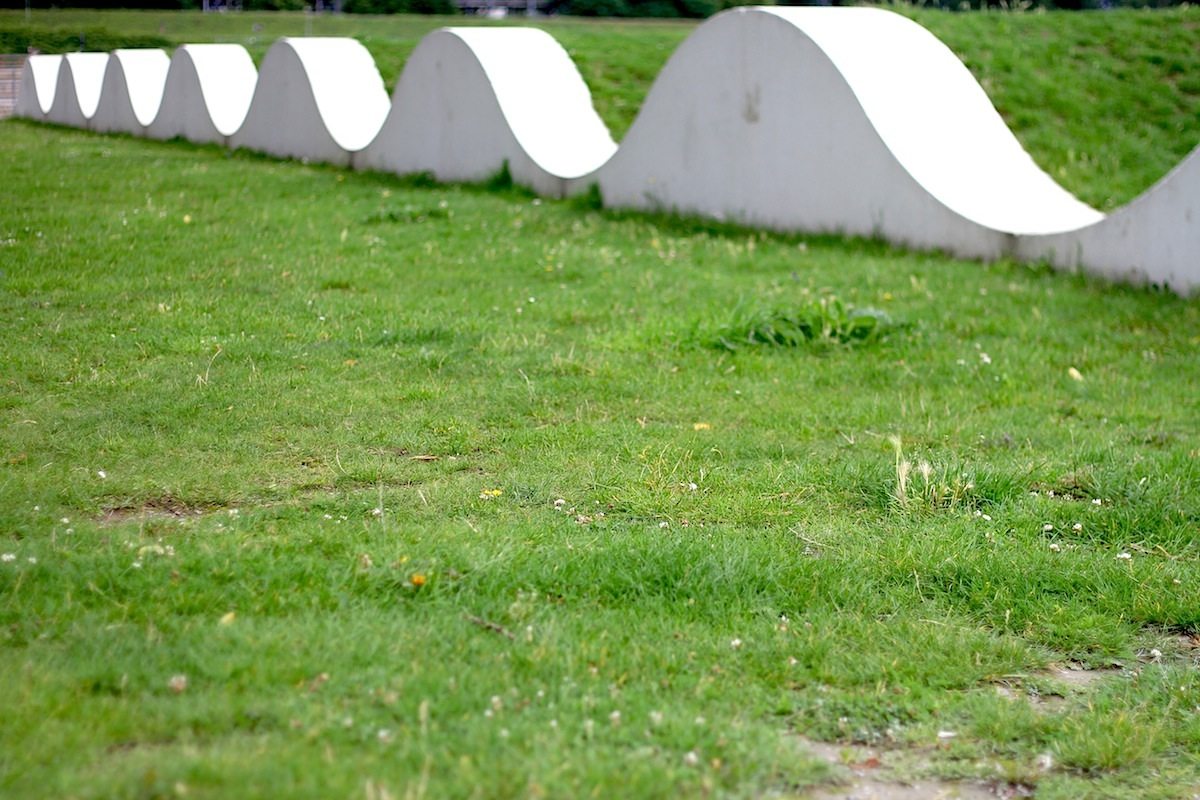
Garten der Erinnerung (memorial garden)
The lawn waves by land art artist Dani Karavan with Danielzik + Leuchter Landschaftsarchitekten bdla (planning of vegetation), Lichtwerke Int. Stefan Hofmann and Belzner Holmes Architektur Licht Bühne / Uwe Belzner.
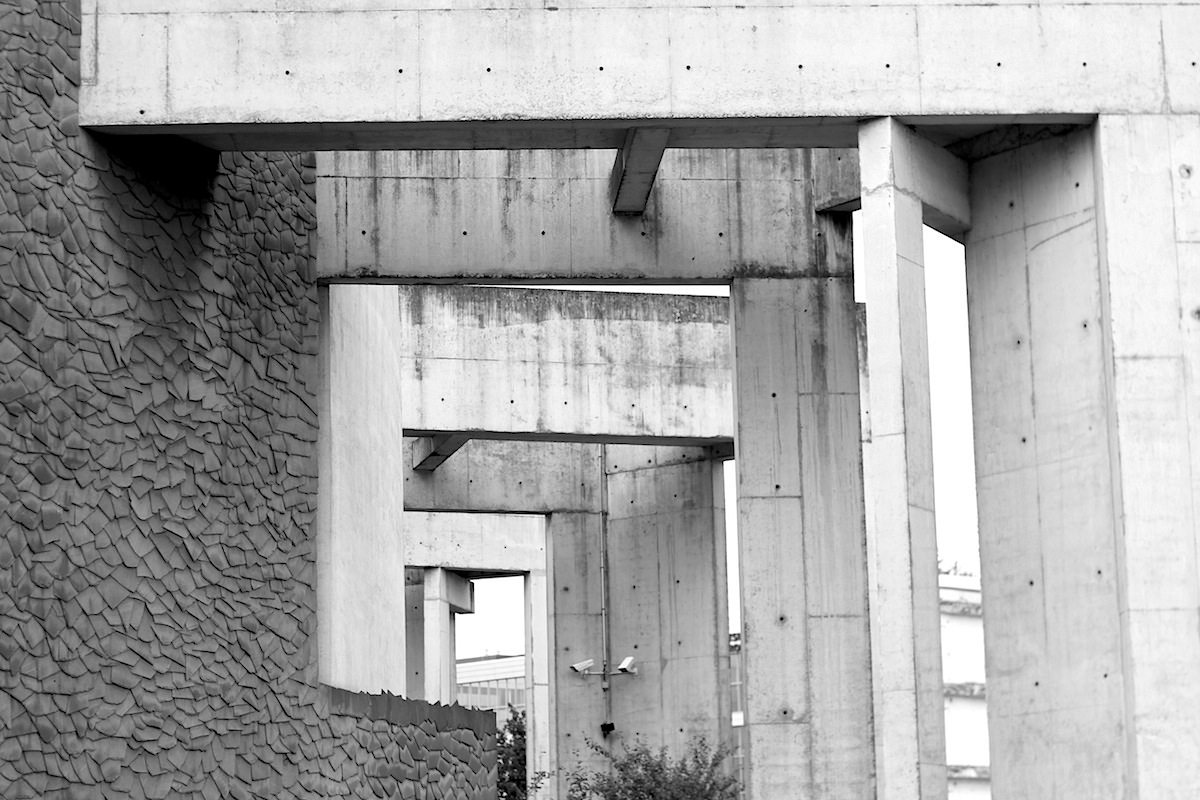
Jewish community centre
The building by architect Zvi Hecker develops from the row of houses on Springwall at the adjacent Altstadtpark in the form of a structural sculpture reminiscent of a hand or an open book. The structure’s five axes refer to places of Jewish history in Duisburg, especially to the site of the old synagogue built in 1875 and burnt down in 1938. The concrete arms stretching into Altstadtpark, which, incidentally, was created by the Dani Karavan, refer to the gigantic silos in the former industrial port.
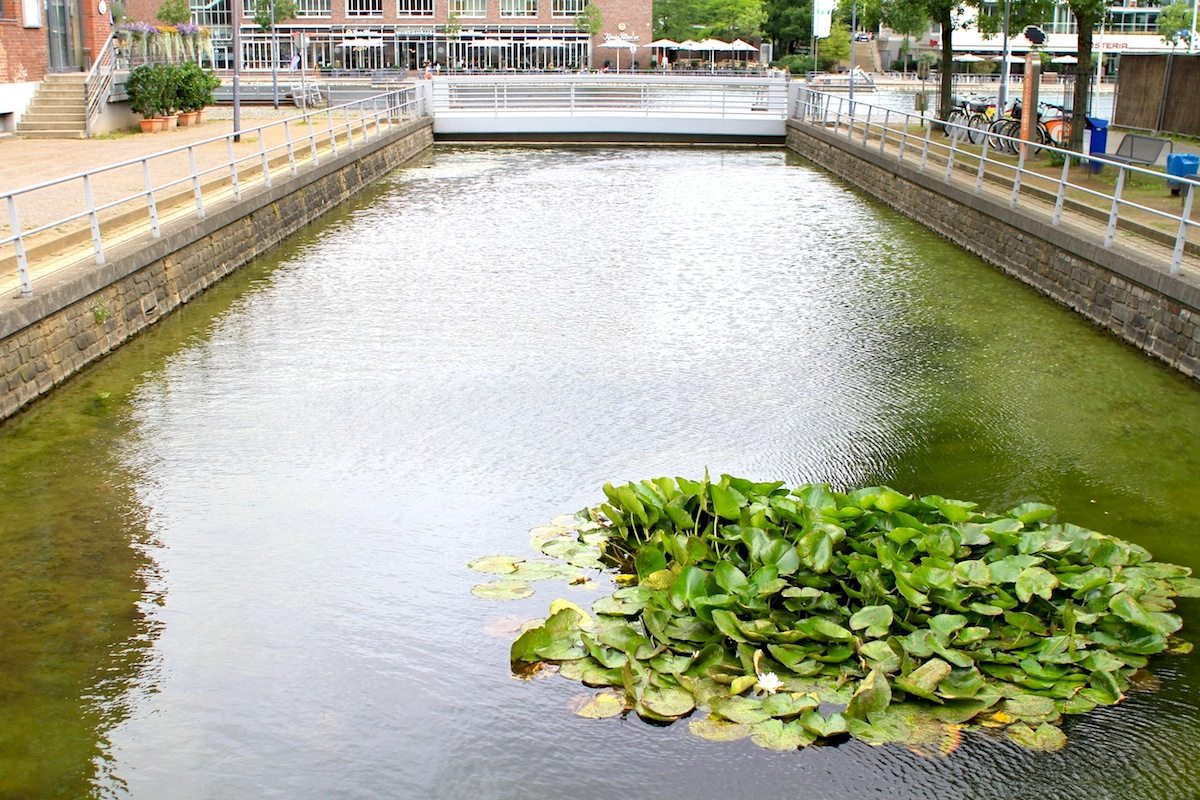
Canals
Part of the master plan: A tree-lined promenade was created along the waterfront and canals were excavated as armatures for new housing development.

Schifferstraße200 @theWater
By Kölbl Kruse. Office building.
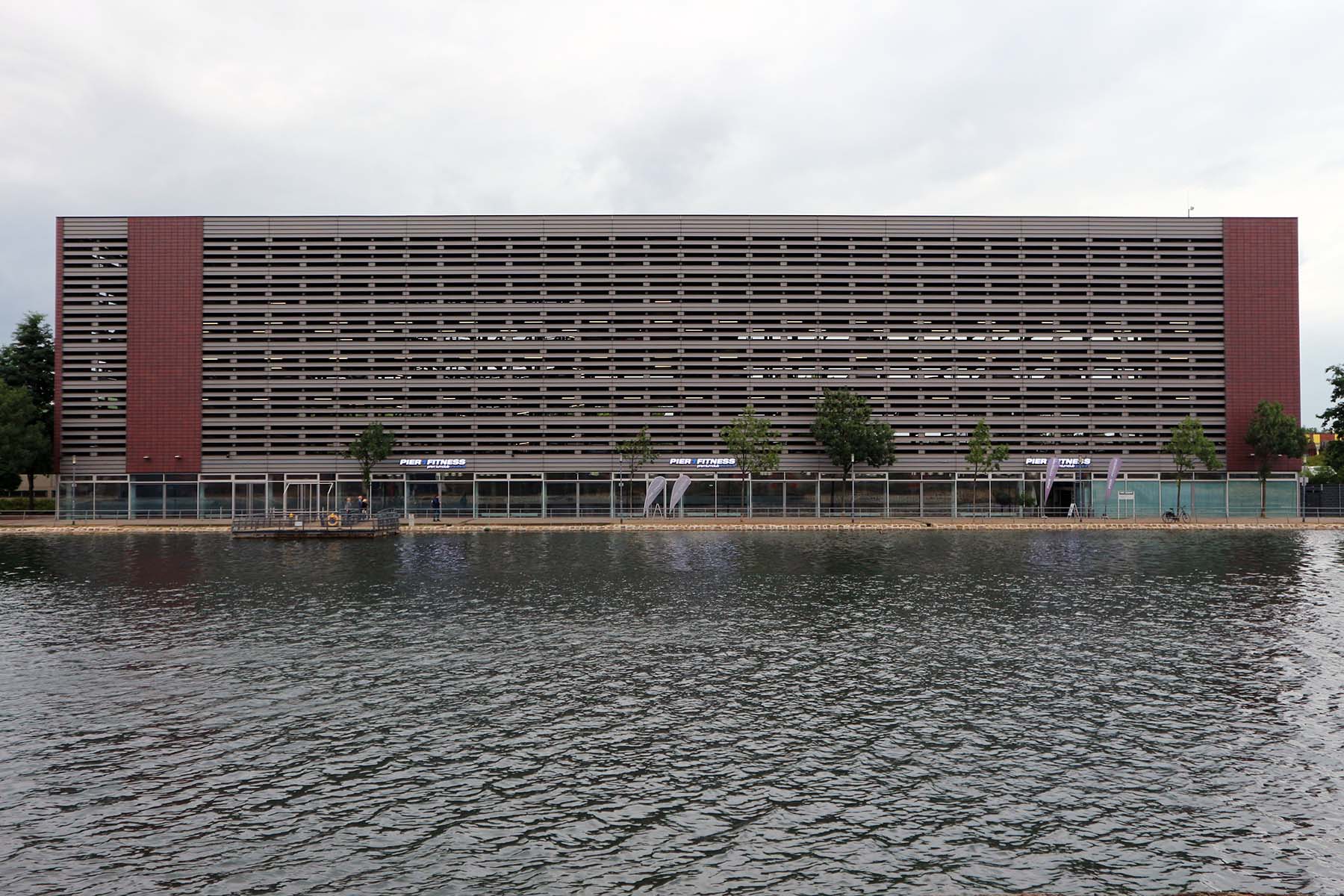
Pier Eins
By Reichel + Stauth, completed 2007

Control Center of the Police in North Rhine Westphalia
By Bahl & Partner, completed 2002

Mitsubishi Hitachi Power Office
By Bahl & Partner Architekten BDA, Hagen with Kölbl Kruse, completed 2007
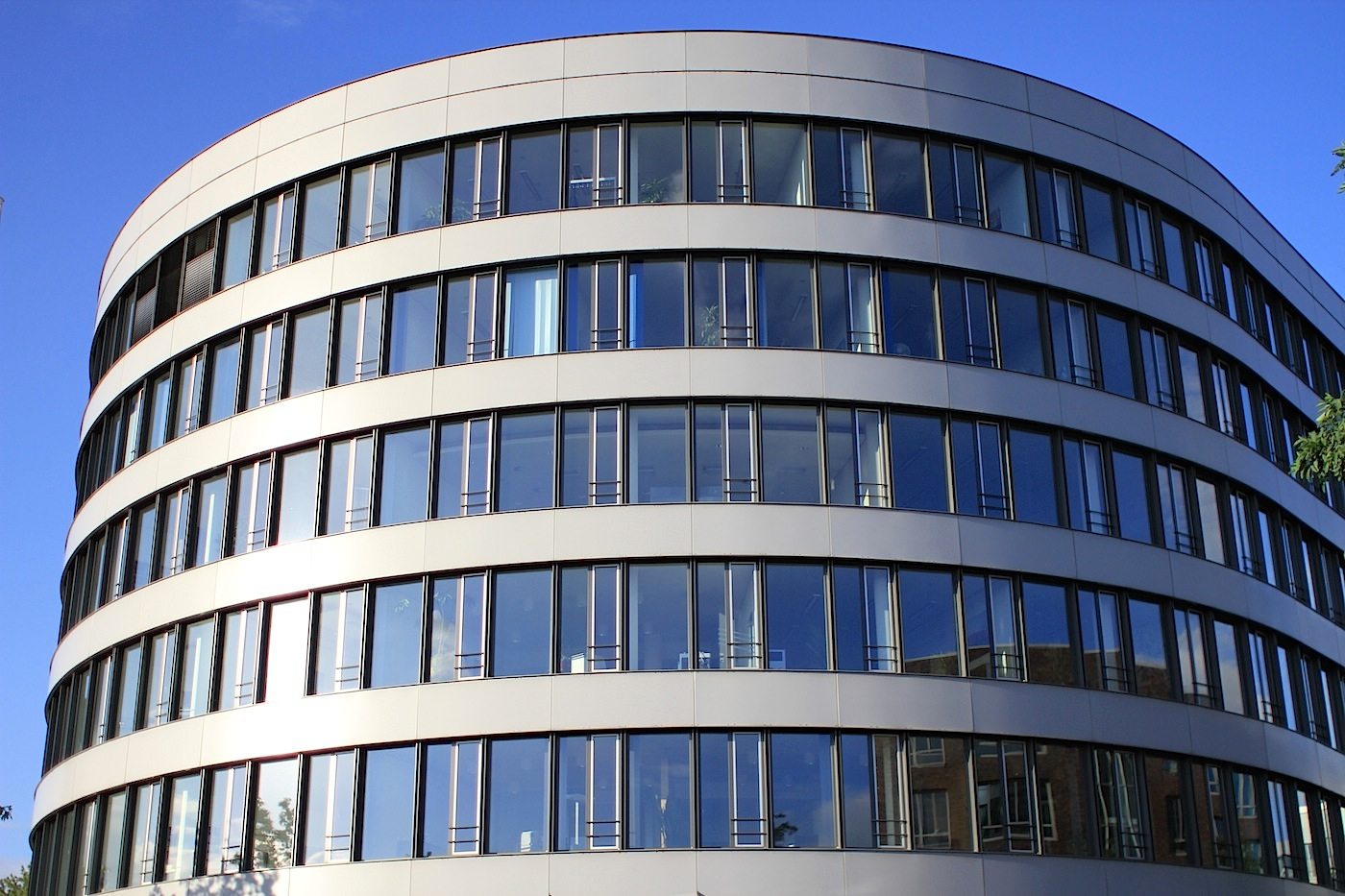
Looper
By Bahl & Partner Architekten BDA, Hagen, completed 2009
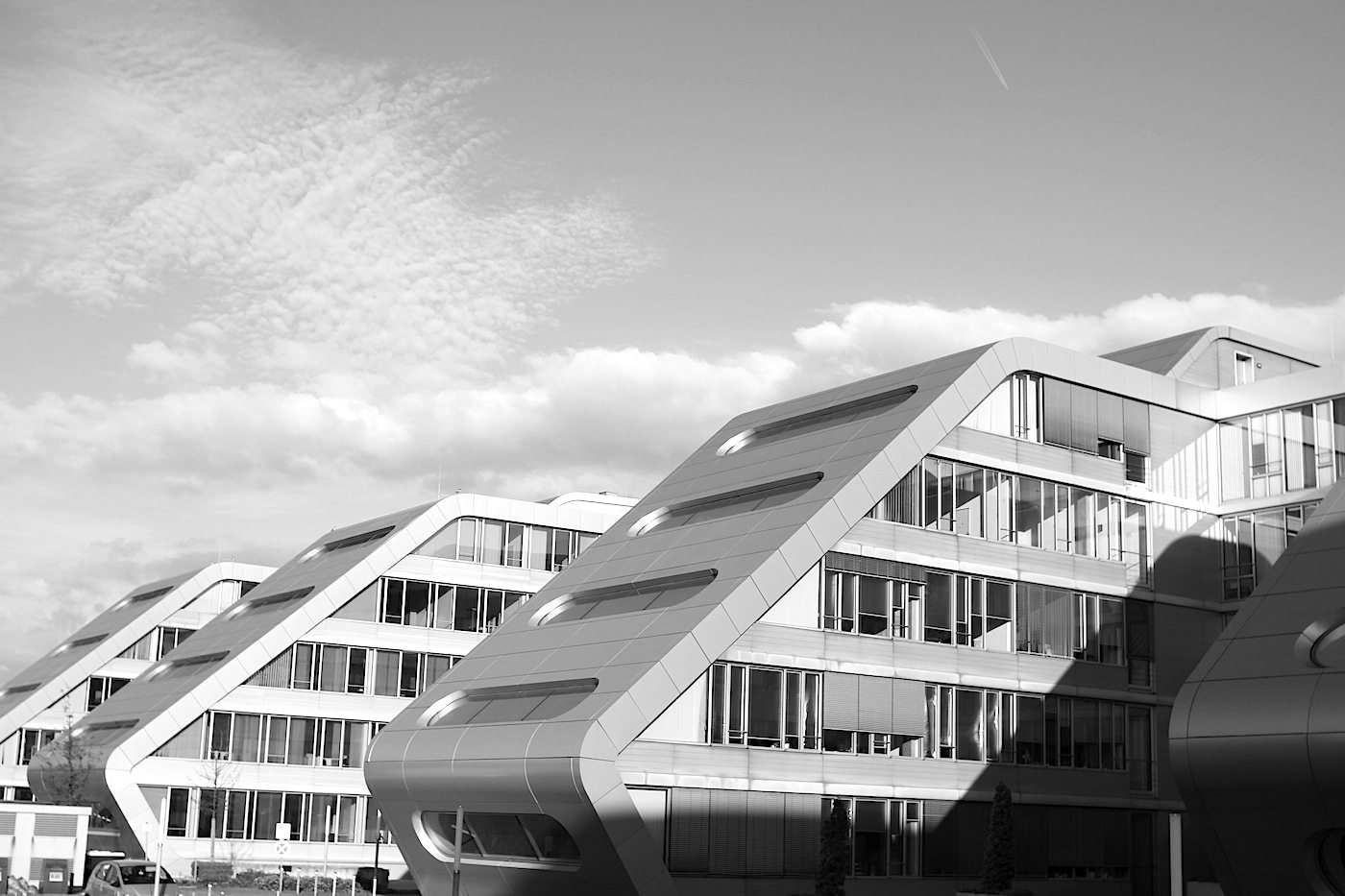
H²-Office
Bothe Richter Teherani, completed 2010

Five Boats
By Nicholas Grimshaw with Bahl und Partner and Kölbl Kruse GmbH, completed 2004

Five Boats
with the marina.

Innenhafen Duisburg
The former centre of German grain trade, with the old mill works and the fresh, shining glass buildings, is a neo-harbour and a piece of "anti-Duisburg."

Innenhafen Duisburg
In contrast to the many bad news items about the city in crisis, with high debts and unemployment, the new Innenhafen wins points with its cultural and architectural attractions. Not so famous as Düsseldorf's Media Harbour or Hamburg's HafenCity, it is thus all the more unified and extensive in its appearance and structure. It is the proof that an originally dingy and forgotten place can become an area for the other, progressive, "Design-Duisburg."
ferrotel
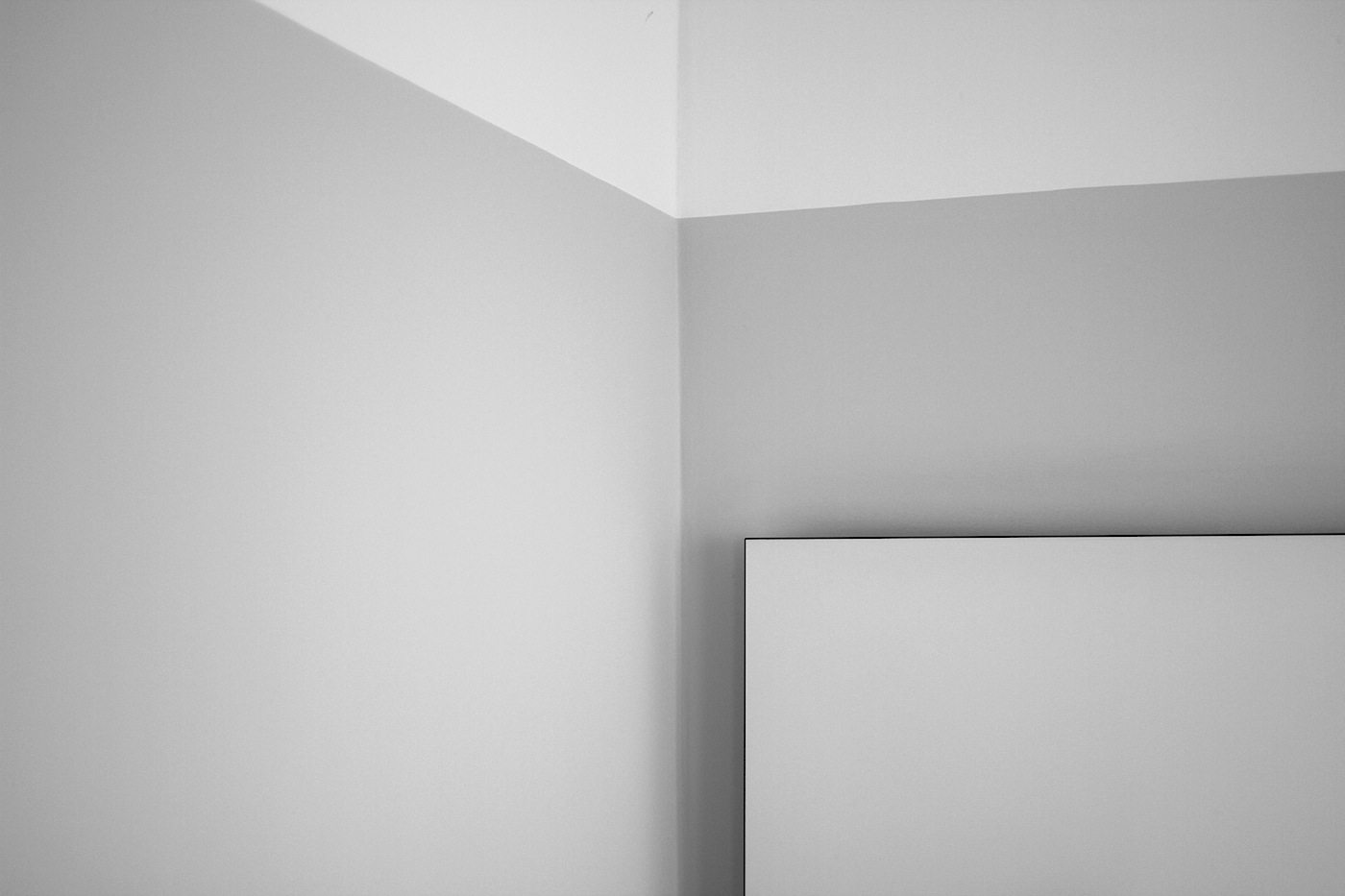
ferrotel
We spent the night in the ferrotel Duisburg, which had invited us during the course of our research.
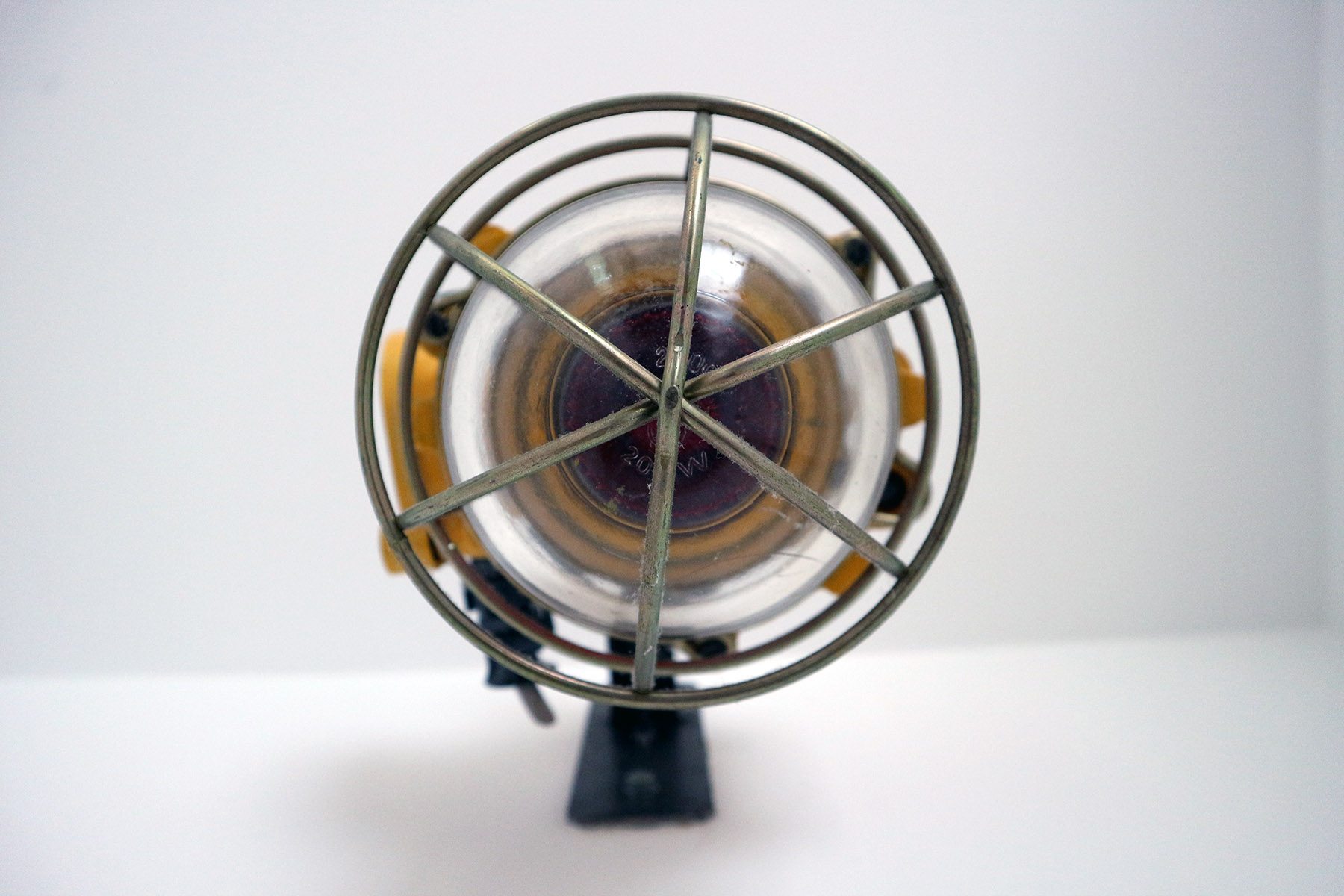
ferrotel
The hotel combines interior design with the feel of an exhibition: objects from the former blast furnace plant Hüttenbetrieb Meiderich-Nord are highlighted as part of the hotel.
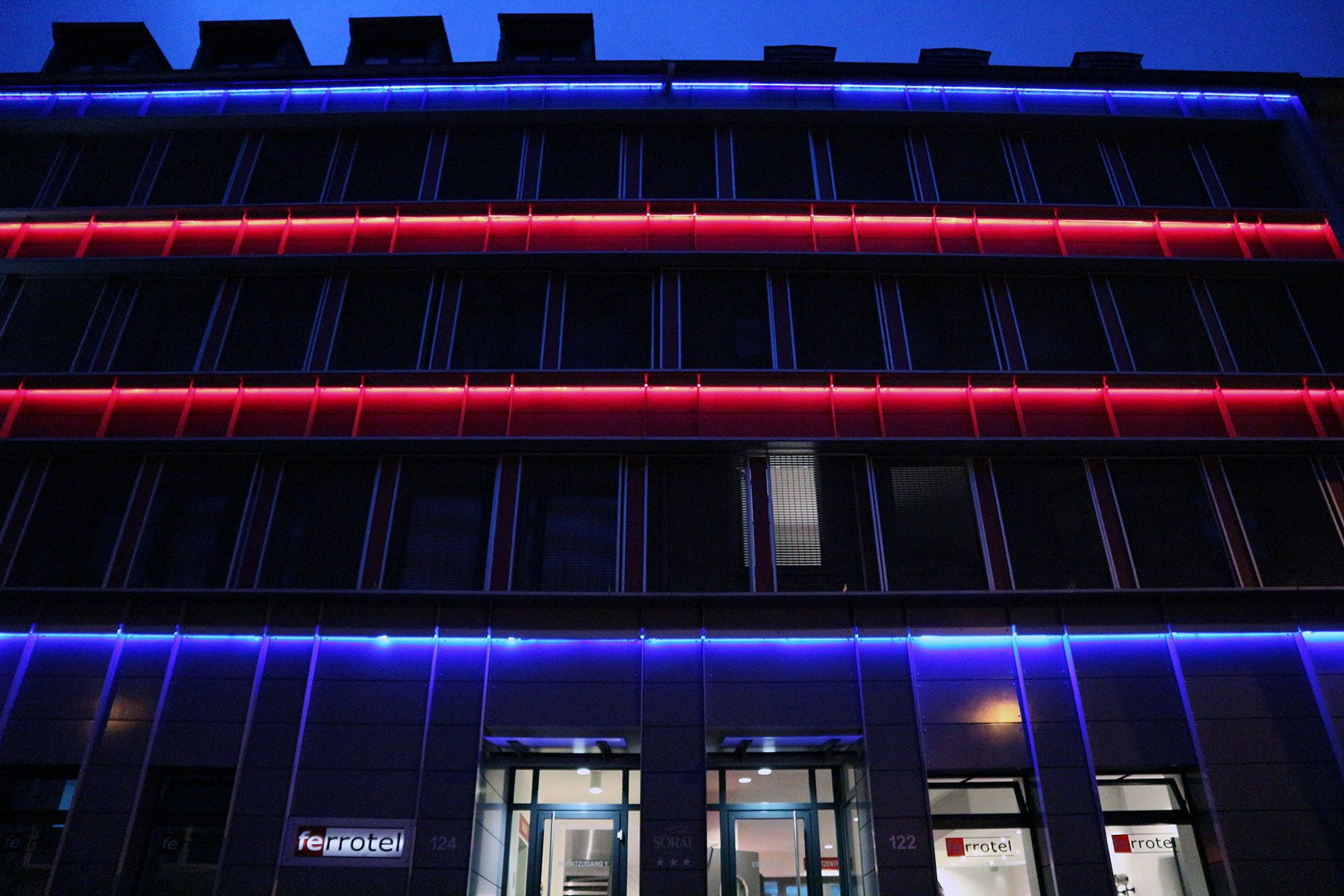
ferrotel
The renovation was planned by Planquadrat Architekten GmbH from Duisburg and realised in multiple building stages (2000, 2004, 2005, 2009).
»The practice's work in Duisburg demonstrates that the trend towards clean, quiet industries has the potential to reinvigorate declining urban areas and create sustainable communities for the future, where home, workplace and recreation are all close by. In place of the zoned and functionally segregated city of the twentieth century, it offers a twenty-first century urban paradigm of mixed-use. With many cafés and restaurants, an art museum, new housing, offices, converted historic buildings and a new park, Duisburg Inner Harbour is becoming a thriving commercial and residential centre in its own right.«
Foster + Partners on their master plan (1991–2003)
Duisburg
A city in North Rhine Westphalia with the world's biggest inland port and close to Düsseldorf Airport, third largest in Germany. Duisburg is the fifth-largest city in North Rhine Westphalia with over 490,000 residents (after Cologne, Düsseldorf, Dortmund, Essen). The city is renowned for its steel industry, in 2000 almost 50% of all hotel metal was produced here. The University of Duisburg-Essen with 40,00 students, ranks among the ten largest German universities. "Duisport" is the largest inland port in the world.
MKM Museum Küppersmühle
Is a Centre for Modern and Contemporary Art based in Duisburg’s Inner Harbour. It houses the Ströher Collection. The works on view provide insights into the oeuvres of influential German artists since the 1950s, with an emphasis on painting with artists e.g. Georg Baselitz, Jörg Immendorff, Anselm Kiefer, Markus Lüpertz, Sigmar Polke, and Gerhard Richter. Based in a former warehouse, the MKM was opened in April 1999. The building was redesigned by the Swiss architects Herzog & de Meuron, using a masterplan devised by Foster + Partners. Address: Innenhafen Duisburg, Philosophenweg 55D, 47051 Duisburg. Opening hours Wed. 14–18 Uhr, Thu.–Sun. 11–18 Uhr, closed Mon. und Tue. Admission prices: 6 Euro for the collection, 9 Euro for the entire museum.
Land Art
variously known as Earth art, environmental art, and Earthworks, is an art movement that emerged in the 1960s and 1970s, largely associated with Great Britain and the United States, but which included examples from many countries. As a trend „Land art“ expanded boundaries of art by the materials used and the siting of the works. The materials used were often the materials of the Earth including for instance the soil and rocks and vegetation and water found on-site, and the siting of the works were often distant from population centers. Though sometimes fairly inaccessible, photo documentation was commonly brought back to the urban art gallery.
THE LINK Tip:
We spent the night in the ferrotel Duisburg, which had invited us during the course of our research. This hotel, located in the Dellviertel neighbourhood, is only a few minutes away from the main railway station, the important Lehmbruck Museum and the inner city. It is about 25 minutes from the Innenhafen by foot, and under 10 minutes by car. The three-star hotel combines interior design with the feel of an exhibition: objects from the former blast furnace plant Hüttenbetrieb Meiderich-Nord are highlighted as part of the hotel. Tables, lights, control panels and other devices have been installed in the lobby, the breakfast room, the halls and the bedrooms, giving the 30-room building a post-industrial character. The renovation, planned by Planquadrat Architekten GmbH from Duisburg and realised in multiple building stages (2000, 2004, 2005, 2009) during active operation, added unity and structure. Because of the building’s different floor heights and windows, the office chose a curtain façade with adjustable aluminium elements. These give the façade a unified, but also user-specific appearance. This aesthetic goes with the red-blue illumination of the façade, which is reminiscent of the industrial character that is typical of the region. Address: Düsseldorfer Straße 122-124, 47051 Duisburg. Tel: 02 03 – 28 08 96 20. E-Mail: ferrotel@sorat-hotels.com.